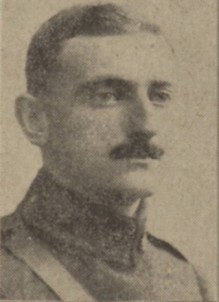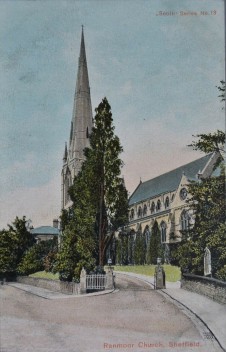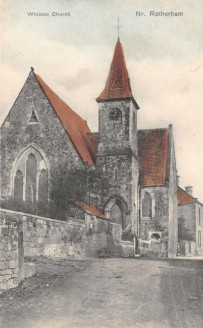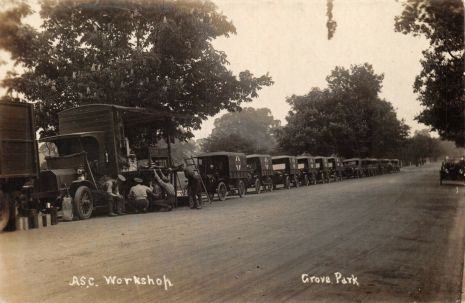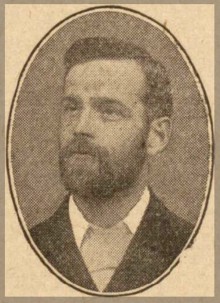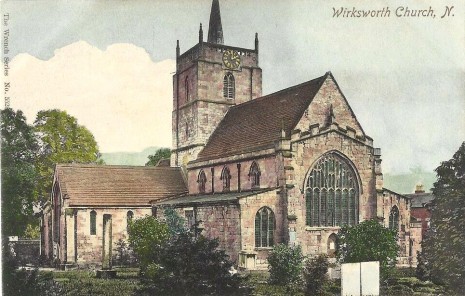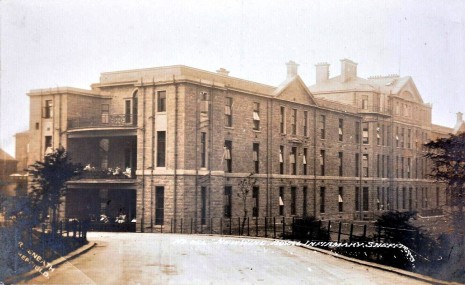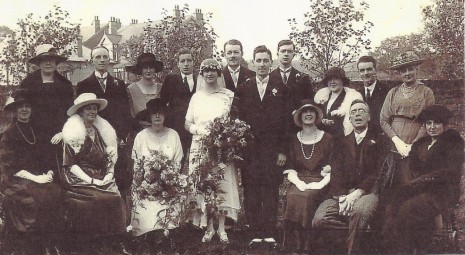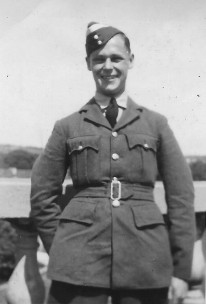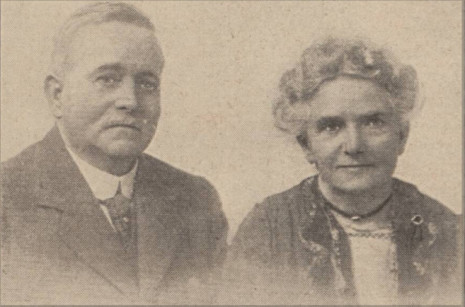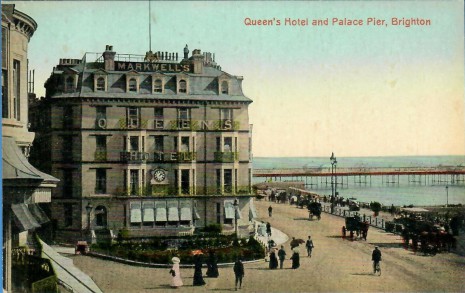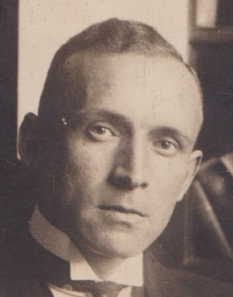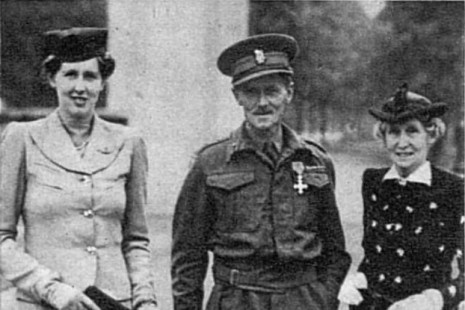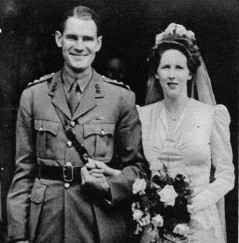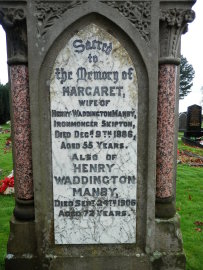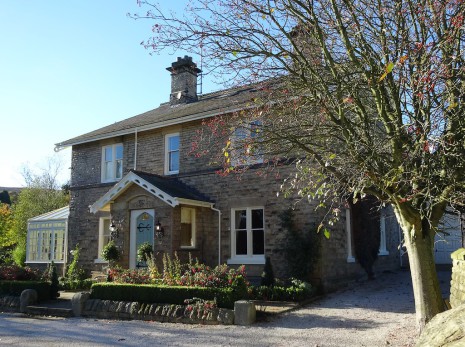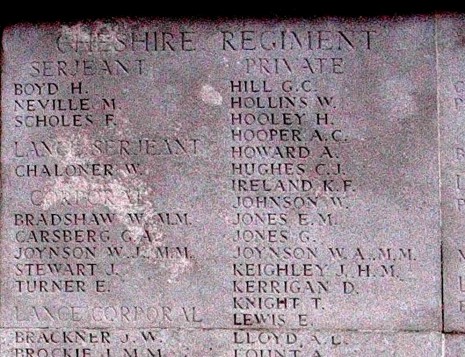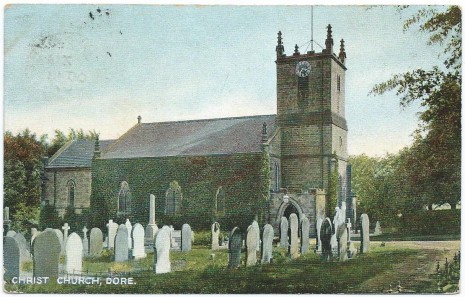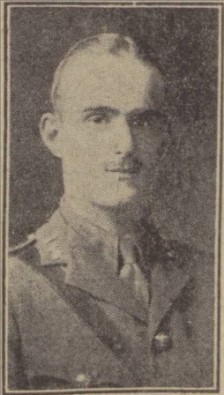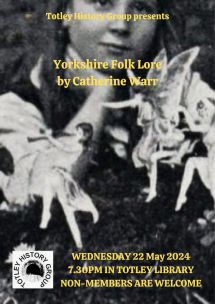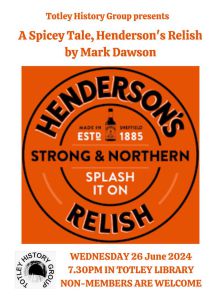WW1 Roll of Honour - The Survivors F-K
Please see War Memorials and Rolls of Honour for the names of local WW1 soldiers and links to other soldier's stories.
Lionel Georges Fauvel
Lionel Fauvel was born in Paris, France in 1894. His father was Owen Charles Fauvel, known as Eli, who was born in St. Helier, Jersey on 29 January 1856, the third of six children of Elias Fauvel, a tailor, and his wife Amelia Colan who married in Jersey around 1847. Lionel's mother was Lavinia Hannah Moore who was born in Chatham, Kent on 13 February 1864, the seventh of eight children of Charles Moore, also a tailor, and his wife Elizabeth Wyley who were married at St. Nicholas, Deptford, Kent on 15 May 1853.
Lionel's parents married at the British Embassy in Paris on 18 December 1880 although neither of them were living in France. It was a double wedding. Eli's sister Phyllis Adelaide Fauvel married Thomas William Moore, Lavinia's brother.
Eli Fauvel was a tailor like his father to whom he had been apprenticed. Their first child, Lavinia Emily, was born in New Cross, Kent towards the end of 1881. A son, Owen Charles junior, was born in Clapham, Surrey on 16 November 1883. Their next two children were born in New York, Alice Amelia on 27 August 1886 and Gertrude Winifred the following year.
The Fauvel family appear to have returned to England just after the next census was taken. Maud Elizabeth was born in Liverpool on 18 May 1891. Their stay in England was a brief one, however, because Lionel was born in Paris on 13 December 1894. They lived in Paris for at least a decade and Lionel received his early schooling there.
The Fauvels returned to England but why they came to Sheffield we do not know. Owen junior married Ida Ann Walton at St. Andrew, Sharrow on 6 January 1909. Ida was born in Sheffield on 27 March 1890, the sixth of eight children of Thomas Walton, a grocer, and his wife Frances Ann Swift who had married at St. John the Baptist, Dronfield on New Year's Day 1878. Owen and Ida went to live in Harlesden, Middlesex. Owen was a ladies tailor and cutter working for Harrods of Knightsbridge. A daughter Ida Alicia was born on 18 May 1910.
Gertrude Fauvel married Edgar John Kay, an insurance inspector, in 1910. Edgar was born in Rotherham in 1950, the sixth of seven children of John Kay, an iron moulder, and his wife Sarah Milnes who married on 13 August 1871 at Christ Church, Attercliffe. Gertrude and Edgar made their home at Holly Mount, Victoria Road, Totley Rise where their first child John was born on 29 August 1911.
That left just four of the children, Lavinia, Alice, Maud and Lionel at home with their parents at Brookside, Abbeydale Road South, Beauchief on Census night 1911. No occupation is recorded for the three daughters but Lionel was apprenticed to his father as a ladies tailor.
Two more of Eli and Lavinia's daughters married before the war. Alice Fauvel married Arthur Stanley Taylor, an electrician, at St Oswald, Bannerdale Road, Sheffield on Christmas Eve, 1913. Arthur was born in Sheffield on 18 September 1886, the first of three children of Samuel Arthur Taylor, a master cabinet maker, and his wife Rose Hannah Grayson who had married at Hathersage Parish Church on 30 June 1884.
On 3 July 1915 Maud Fauvel married Thomas Harold Ball, a scissors manufacturer, at St John the Baptist, Abbeydale. Thomas was born on 1 March 1890 in Sheffield, the second of four children of Thomas Ball, a surgeon's son of independent means, and his wife Mary Hotham who had married at Handsworth Parish Church on 15 June 1887.
When the family first arrived in Sheffield, Lionel attended the Royal Grammar School and afterwards King Edward VII School. His war service record has not survived but we know that by he joined the territorial force of the Queen's Own Yorkshire Dragoons as Private number 2484 and was soon promoted to Lance Corporal. In May 1913 he passed the signaler's examination. Shortly after the outbreak of war he was mobilized and sent to France on 16 July 1915 with the British Expeditionary Force. After a further promotion to Sergeant he was awarded the Military Medal for bravery whilst acting as an observer at the Front. He transferred into the military wing of the Royal Flying Corps as an observer and after a probationary period of flying at the Front he received his commission as a Second Lieutenant on 23 October 1916.
Lionel was wounded three times between 26 January 1917 and 25 May 1917, the last of which was a gunshot wound which fractured a femur. After being treated at the field hospital he was transferred to Queen Alexandra's Military Hospital, Millbank on 20 July 1917. On 22 December he was sent for convalescence to Brighton and afterwards to Caernarvon but he never returned to active service. He relinquished his commission because of ill health and was formally discharged from service on 9 March 1919. After the war, Lionel was awarded the 1915 Star, the Victory Medal and the British War Medal.
On 13 November 1918, two days after Armistice Day and whilst still a serving officer in the RAF, Lionel Fauvel married Jessie Oxspring at St. John's, Ranmoor. Jessie was born in 1894, the youngest of three children of George Oxspring, a cutlery manufacturer, and his wife Ellen Sykes who had married on 26 August 1884 at All Saints, Brightside. After a honeymoon in Llandudno, Lionel and Jessie lived for a time with her parents at 50 Westwood Road, Ranmoor.
Around 1922 Lionel and Jessie moved to Folkestone. Lionel established a high class ladies drapers at 19 Cheriton Place and they lived at 59 Cheriton Road until 1930. It would appear that Lionel and Jessie separated early in 1931. They had no children. Lionel was living alone at Effingham Road, Long Ditton near Surbiton, Surrey at the end of 1931 but later he went to live with his aging parents.
In 1937 Lionel, Eli and Lavinia were at 8 St. James's Close, Eastcote, Ruislip in Middlesex and they were still there when the National Register was made up on 20 September the following year. Lionel's occupation was recorded as ladies tailor's cutter and he is still recorded as being married. He was also a voluntary air raid warden. Eli died in 1943 aged 87. Lionel lived with his mother until after the war but by the end of 1945 he had moved to Hendon, Middlesex and then by 1947 to Ashburnham Mansions, Chelsea where he was still living in 1953 when Lavinia died in Eton aged 89.
We do not know whether Lionel and Jessie were divorced or whether she died but Lionel married again in 1954 in Sussex to Margaret Zoe Wright, a secretary. Zoe, as she was known, was born on 12
September 1915 the third daughter of George Wright, a consulting engineer, and his wife Margaret Clarke who married at Holy Trinity, Hull on 29 April 1908. Lionel and Zoe may have met through
Lionel's eldest sister Lavinia, who lived in Hull. She was a trained nurse who had served in a VAD during the first war. Lionel and Zoe lived at Rosemary Cottage, Hawkham Pevensey, East Sussex.
Lionel died on 10 Jun 1986, aged 91. Zoe died on 26 Jun 2003, aged 87.
Leonard Shelley Fletcher
Len Fletcher was born in Rotherham in 1896. His father was Leonard John Fletcher who was born in Rotherham in 1867, the younger son of John Davy Fletcher, a grocer, and his wife Eleanor Hodgson who had married on 2 June 1864 at Rotherham Parish Church. Len's mother was Florence Haywood, the younger daughter of Walter Haywood, a designer and wood model maker, and his wife Emily Heaton who had married in South Shields, Durham in 1900.
Len's parents married on 18 May 1895 at Whiston Parish Church, Rotherham. The marriage register shows that Leonard was a bank clerk living at 7 Clifton Grove, Rotherham and Florence was living at Whiston Grove. She had been a school governess in the 1891 Census. Len was their first child born on 5 March 1896. In the next census on 31 March 1901 the Fletchers were living at 4 Springfield Road, Millhouses. A daughter, Barbara, was born on 26 September 1905. The 1911 Census shows that the Fletcher family had moved to 3 Prospect Road, Totley Rise where they would remain for more than twenty years. Leonard was a cashier with the Sheffield and Hallamshire Bank which had its headquarters on Church Street, Sheffield and branches at Highfield, Abbeydale and Woodseats amongst others. It was absorbed into Midland Bank in 1913.
Len Fletcher was educated at Dore and Totley High School from 1904 to 1908 and then at King Edward VII School in Sheffield until 1914. On leaving school, he became an engine turner and fitter. Len attested on 8 December 1915 in Sheffield when aged 19 but was not mobilised until 16 February 1917 when he was posted as Private number M/295196 to the Mechanised Transport Depot of the Army Service Corps at Grove Park, Lee, near Lewisham, Kent. As well as driving lorries and probably ambulances he was a mechanic and fitter.
Len was sent to East Africa with the Expeditionary Force embarking at Devonport on 9 March 1917 and disembarking at Dar Es-Salaam on 20 May. In the three months he was in Africa, he caught malaria and was hospitalised for 15 days in two separate spells. He embarked for England from South Africa on 18 November 1917 and remained on the Home Front until he was demobilised on 25 October 1919. He had been hospitalised with malaria a further six times before he left the army. Len was later awarded the Victory Medal and British War Medal for his contribution to the war effort.
After the war, Len was apprenticed to Messrs G. and J. Hall Ltd. of Hereford Street, Sheffield, who manufactured small, specialised tools for engineers. The firm was highly respected having been started in 1867 by the senior brother, George Hall, who went on to become Master Cutler in 1904. Len's practical training was complemented by technical education at the Department of Applied Science, Sheffield University where from October 1920 he followed a course in engineering. He applied for membership of the Institute of Mechanical Engineers and was awarded Graduate status on 16 January 1923. He would remain a member of the Institute until June 1940 when he resigned.
In 1932 Len married Freda Catherine Singleton of Devonshire House, Devonshire Road, Totley Rise. Freda had been born on 31 October 1903 in Sheffield, the second of four children of Frederick
Singleton, a pearl cutter, and his wife Rosie Hedley who had married in South Shields, Durham in 1890. Rather sadly Freda's father died shortly afterwards on 8 October at the age of 56. He had had an
interesting life being the eldest of 15 children in a poor Sheffield family and had risen to owning his own highly successful business on Arundel Street, Sheffield. He was the first pearl cutter in
Sheffield to dispense with the use of sand stones for grinding but doubtless the early years had taken their toll. An all-round sportsman he was a noted marksman who had attended Bisley for many
years and was a prize winner there in 1926.
Len's own father died on 10 September 1933 at the age of 66. He was cremated at City Road Crematorium two days later. When the 1939 National Register was compiled Len had had a complete career change
and had become the proprietor of a guest house in Cornwall. With him at Trelawne, Maenporth Hill near Falmouth were his wife Freda, mother Florence, sister Barbara and niece June. Barbara had married
Ronald Sydney John Unwin at St John the Baptist, Abbeydale on 16 June 1926. Their story is told elsewhere on this page.
How long the Fletcher family stayed in Cornwall we do not know but from newspaper advertisements we can see that the guest house was being run by another family in 1947 and the Fletchers were
certainly back in Totley Rise by April 1948, living at 2 Devonshire Road. Florence died there on 17 August 1955, aged 85, and from the probate of her will we can see that Len was employed as a works
manager. Len and Freda later moved to Hathersage, living at West Winds, Coggers Lane. Len died on 12 March 1974, aged 76, and Freda on 10 October 1978, aged 74.
John Hubert Fox
Hubert Fox was born in Bradway in 1895. His father was Edmund Fox who was born in Norton around 1869 and baptised at Beauchief Abbey on 9 January 1881, the son of Martha Fox, a single woman. Edmund was brought up in Bradway in the household of his great uncle Samuel Fox, a farmer. Martha had been Samuel's housekeeper after his wife Elizabeth died. Hubert's mother was Mary Jane Sheard who was born in Gomersal, Yorkshire in 1871, the second of three children of Richard Sheard, a colliery manager, and his wife Mary Johnson who married in Dewsbury, Yorkshire in 1870.
Hubert's parents married on 23 March 1892 at St. John the Baptist, Dronfield. Edmund Fox was a joiner and builder who lived at Bradway. Mary Sheard was a Board School teacher living in Stubley, Dronfield. They lived at Bradway where their first child, Harold Edmund, was born on 10 May 1893. Hubert was their only other child, born in April 1895. In the 1911 Census the Fox family lived at Moorland View, Queen Victoria Road. Harold had become a student teacher whilst Hubert was a joiner and builder like his father.
In December 1914 Hubert was recruited at Sheffield into the Coldstream Guards. Aged 19, he was tall for the times at 5ft 10¼ inches. He attested on 21 December 1914 in Caterham, Surrey becoming Private number 14269. He was promoted to Lance Corporal on 27 May 1915 and was sent to France with the British Expeditionary Force on 10 August 1915. By 20 August Hubert was in the trenches. In December, he wrote a letter to his former schoolmaster, George Lee Waine, of Dronfield Woodhouse, an extract of which was published by Belper News on 12 November 1915. It read:
We have done three weeks in the trenches. The day after we went in the Germans shelled our trenches unmercifully for seven hours, causing us considerable trouble and many casualties. When one of their big shells drops it makes a hole big enough to put a horse and cart in, so you can guess what it is like being in the trenches when those are flying about for seven hours. I was fortunate enough not to get hit, but I got buried twice with shells bursting on the top of the trench and sending the sides in where I was laid in the bottom. You can hear them coming for seconds before they burst and that time is awful waiting for them. It is a great relief when you hear it a little way off and then you have to keep down from the pieces of shell that come after it. The Germans attacked after the bombardment, but as you would see by the papers, they only got within 40 yards of the trench, for we mowed them down with rifle and machine guns as they came. It is not so bad in the reserve and support trenches, as you get warned if anything unusual happens. We are in the German trenches that we captured during the recent advance, and they are fine ones and no mistake except that they are the wrong way round for us so we have had to reverse them. There were 100 yards of barbed wire in front of them and dug-outs 10 and 20 feet below the ground. If they had been ours we would have defied anybody to take them from us, but thanks to our artillery they completely blew them to pieces. The food question in the trenches is rather an awkward one, but I have nothing to grumble at, as we are our own cooks, so we cook it to our own liking, that is when Mr Fritz will allow us, but of course when he is troublesome we have to get it the best we can. We are at present back behind the firing line for a few days' rest.
Hubert was wounded in action on 26 September 1916 having been shot in the back of his leg. Whilst in hospital he was promoted to the rank of Corporal on 11 November. He was passed fit to rejoin the front on 30 November 1916. A second gunshot wound on 30 November 1916, this time to the right shoulder, proved to be much more serious causing fractures. He was returned to England on 5 December and spent 104 days in the 2nd Western General Hospital in Manchester. Following his discharge on 18 March 1918 Hubert spent the rest of the war on the Home Front with postings to Aldershot and later to Windsor where he was promoted to Acting Sergeant on 1 August 1918. He was finally discharged from the army on 10 March 1919 and issued with Silver War Badge number 13218876. He returned home to his family at Moorland View.
Hubert was best man at his brother's wedding at St. John the Baptist, Dronfield on 29 July 1925. The bride was Doris Lilian Elshaw, the younger daughter of Joseph Seddon Elshaw, an iron founder and his wife Ann Lancaster who had married at the same church on 3 October 1886. Harold Fox had been appointed headmaster of Dronfield Endowed School in March 1925. On 15 September the same year Hubert married Doreen Poplar also at St. John's. Doreen was born in 1900 in Hathersage, the only daughter of Arthur Smedley Poplar, a gas inspector, and his wife Mary Jane Wall who had married at Dronfield on 12 August 1897.
Both marriages were to be tragically short. Doris Fox died in hospital in Sheffield on 2 April 1936, aged 36. She left a son John aged 7. Then Doreen Fox died in Dronfield in early 1938, aged 38, leaving two children: Mary aged 9 and Dennis aged 5. Hubert Fox died on 23 October 1938 at the Royal Infirmary aged 43. He was buried at Abbey Lane Cemetery three days later.
Jasper Keith Frewing and Rev. Jasper John Frewing
Jasper Keith Frewing was born in 1900 in Thatcham, Berkshire. He was known as Keith to distinguish him from his father Jasper John Frewing who was born in Great Marlow, Buckinghamshire in 1865, the second of five children of Henry Frewing, a postman, and his wife Emma Croxon who married in Lewisham, Kent in 1862. Keith's mother was Maria Clara Cousins who was born in Abingdon, Berkshire in 1850, the youngest of nine children of William George Cousins, a coach builder, and his wife Louisa Smith who had married in Thanet, Kent in 1838.
When Keith's parents married it was his father's second marriage as he had earlier married Blanche Maria Harris at Tewkesbury, Gloucestershire on 11 August 1892. Blanche had been born there in 1865, the fourth of eight children of Charles Harris, a plumber and builder, and his wife Emma Morse who had married on 9 October 1859. The couple had met shortly after Jasper left Bristol College to serve as the assistant pastor at Hadleigh Congregational Church, Suffolk. On 4 May 1893 Jasper was ordained pastor of the Congregational Church, Faringdon, Berkshire. Sadly Blanche died from influenza at The Manse, Faringdon on 26 February 1894 aged 28.
Whilst in Faringdon, Jasper became a member of the parish council and a much loved and valuable member of the community. He also gained a reputation as a writer of short and interesting stories for newspapers and magazines. On 6 August 1896 Jasper married Maria Cousins at the Congregational Chapel, Abingdon. Two of her brothers were also ministers and for many years she had been associated with the work of the chapel and its Sunday School. In January 1900 Jasper was appointed the pastor of the Congregational Church of Thatcham and he began his ministry on 4 February. Soon after, his only son was born on 27 April.
On 30 July 1906 it was announced that Rev. Jasper Frewing had accepted the position of assistant pastor to Rev. Edward Harper Titchmarsh at Nether Congregational Church, Norfolk Street, Sheffield. The church had scope for two ministers as it had mission stations at Old Street and Sussex Street and the two men had known each other for over 15 years. Jasper and his family moved to Sheffield in October 1906. He resigned his appointment on 1 February 1909 as he considered his future work lay amongst young people and that the Nether Church should not have to bear his finances. His resignation was reluctantly accepted and later that month Jasper was named as secretary to the Boys Life Brigade Battalion which had become an integral part of the Sheffield Sunday School Union. At the Brigade's annual meeting on 8 November, Jasper was able to report membership had grown to around 700 boys, 90 officers and 16 companies.
On 16 January 1910 it was announced that Jasper had been invited to become the first pastor of the newly formed Dore Union Church. He began his ministry the following month whilst retaining his role with the Boys Life Brigade. Services were conducted in a temporary iron building (the "Tin Tab") located close to Dore and Totley Station. Rev. Frewing and his family made their home at Dunedin, 138 Totley Brook Road. On 22 May 1913 a new stone-built church was officially opened on Totley Brook Road. In January 1914 Jasper reported that Sheffield Boys Life Brigade now numbered 1,200 boys and 120 officers.
When war broke out Rev. Frewing was active through the YMCA in fund raising and entertainment for wounded soldiers. He had a shooting range installed on land adjacent to the church and had the schoolroom converted to into a recreation room for the their use. As well as games and pastimes, the soldiers used the hall for letter writing. So great was the volume of letters - thousands were written weekly - that special arrangements had to be made with the Post Office authorities in Sheffield for their collection and onward distribution.
Recognising his contribution, the YMCA invited Jasper to undertake the leadership of a similar role in France which he readily accepted. He disembarked on 24 January 1917 but was soon forced to abandon his work having contracted bronchopneumonia. He was admitted to No. 2 General Hospital on 7 February and was so dangerously ill that his wife was sent for immediately. He remained seriously ill for several days but thankfully pulled through and was able to leave hospital after 31 days for convalescence back in Totley Brook. It would not be until 10 September, however, that he was well enough to resume his duties at the Union Church. He was later awarded the British War Medal for his service in France.
Keith Frewing was educated at Chesterfield Grammar and at Taunton School, Somerset. On 27 April 1918 he enlisted at Cambridge as an army cadet and was called up on 18 September and posted to the 5th Regiment of the Durham Light Infantry as Private number 88463. It would appear from the surviving war service records that Keith did not serve overseas.
Rev. Jasper Frewing resigned from his position at Dore Union Church in 1919 because of ill health and for a year became the president of the Sheffield Congregational Association before accepting the ministry at Woodhouse Congregational Church in September 1920. He lived with his wife and son at The Manse, Beighton Road, Handsworth until 1924 when further ill health caused him to retire permanently from ministerial life. He retired to Painswick, Gloucestershire having served the church in Sheffield for 18 years.
Rev. Jasper John Frewing of St. Michael's, Painswick, died on 22 November 1933, aged 68, and was buried three days later, the funeral service being conducted by his old colleague and friend, Rev. Titchmarsh. Jasper's wife Maria continued to live in Painswick for the rest of her life. She died at Upton Knoll, Upton St. Leonard's, Gloucestershire on 10 April 1950, aged 90.
Keith Frewing married Carrie Lois Ponfield in Bath in 1930. Carrie was born on 10 October 1880 in Wellingborough, Northamptonshire, the only child of Edward Charles Ponfield, a cycle works manager, and his wife Carrie Elizabeth Smith who married in Bath in 1898. Keith had moved to Ealing, Middlesex before his marriage and for most, if not all, of their married life Keith and Carrie lived at 49 Wyndham Road, West Ealing. In the 1939 Register Keith was shown as a pharmacist and manager of a retail chemists shop.
He made the newspapers in 1961 when he was was a guest of the Health Minister, Enoch Powell, at a presentation and party to mark giving fifty donations to the National Blood Transfusion Service. Carrie died on 30 November 1963 at West Middlesex Hospital, Isleworth and was buried on 5 December at Ealing and Old Brentford Cemetery. She was aged 57. Keith died on 15 March 1969, aged 68, and was buried in the same grave six days later. They had no children.
Cyril Ewen Gardiner
Cyril Ewen Gardiner was born on 14 October 1897 in Totley Rise. His father was Samuel Gardiner who was born in 1870 in Thrupp, Gloucestershire, the elder son of Enoch Gardiner, a carpenter, and his
wife Harriet Smith who married in Stroud, Gloucestershire in 1868. Cyril's mother was Christina Cameron who was born in Fodderty, Ross-shire in 1872, the eighth of nine children of Ewen Cameron, a
builder, and his wife Christina McRae.
Cyril's parents married on New Year's Eve 1896 at All Saints Church, Ecclesall. Samuel Gardiner had come to Sheffield with the Midland Railway before 1889 and had worked his way up from being a carriage washer to a signalman by the time he married Christina. Christina had moved to Sheffield with her younger sister Jessie after their father died in 1895. After their marriage, Samuel and Christina lived in Lemont Road, Totley where six children were born: Cyril Ewen (1897), Hilda Christina (1899), Iris (1900), Jessie (1903), Katie (1906) and Arthur Willie (1909).
The children attended Totley All Saints School, Cyril from 16 September 1902 to 25 March 1910 when he transferred to Abbeydale School. In the Census of 2 April 1911 Samuel, Christina and their six children were recorded as still living in Lemont Road but only Hilda and Katie would be alive in sixteen years time. Arthur died when he was aged five and was buried at Dore Christ Church on Christmas Eve 1914. Samuel died the following year, aged 46, and was buried at Dore on 7 July. Then Iris died when she was aged 17 and was buried at Dore on 27 October 1917. Her death was closely followed by those of her mother Christina, aged 46, and sister Jessie, aged 14, both buried at Dore on 6 November 1917. Katie, aged 11, was sent to Scotland to live with her mother's family. It was wartime and there was no mention of these tragic events in the Sheffield and North Derbyshire newspapers.
Cyril's war service record has not survived but we know that he joined the Royal Garrison Artillery as a signaller and was later trained as a gunner. He was discharged in January 1920. After the war he married Mary Ann Pendleton at Chesterfield Register Office in 1922. Mary Ann was born in Whittington, Derbyshire in 1899, the seventh of eleven children of Percy Josiah Pendleton and his wife Kezia Springthorpe who married at Sheffield Parish Church on 16 October 1887. Percy Pendleton was an engineer's fitter at the Sheepbridge Works Rolling Mill in Chesterfield and the family lived at 586 and later 871 Sheffield Road. Cyril and Mary Ann lived at 935 Sheffield Road and had two children: Jack Cameron born in 1923 and Norah born in 1925. Cyril died in 1926 aged 28. It would appear that Mary Ann remarried in 1930 to Fred Cooper, a farmer.
William Gee
The name of William (Willie) Gee appears on the Totley Rise Methodist Church Roll of Honour alongside that of his cousin Samuel Crookes. Willie Gee was born in Dore on 22 January 1891. His father was William Gee Snr. who was born in Clowne, Derbyshire in 1828, the third of thirteen children of Samuel Gee, a farmer, and his wife Mary Eliza Warrener who married at Sheffield Parish Church on 10 March 1835. Willie's mother was Mary Ellen Wint, who was born in Ecclesall in 1861, the third of six children of Thomas Wint and his wife Hannah Johnson who married at St. Mary's Church, Wirksworth, Derbyshire on 23 October 1855. Thomas Wint (1836-1901) had many occupations. He was an agricultural labourer, a gardener, and later a cab proprietor at Totley Rise.
Willie's parents had married in Sheffield on 14 July 1886. It was William Gee's second marriage, having previously married Elizabeth Brunt at Whitwell, Derbyshire on 31 January 1858 and raised a family of four children before Elizabeth's death in 1881. William had four more children with Mary Ellen, all born in Dore when the family were living at Ashfurlong Cottages and William was working as an agricultural labourer. They were baptised at the Church of St. John the Baptist, Abbeydale: Ellen Gertrude on 24 July 1887, Harry on 27 October 1889, Willie on 15 February 1891, and finally Thomas Wint Gee on 13 November 1892.
The family moved to Totley Rise and both Gertrude and Willie attended Totley Church School, Gertrude being admitted there on 22 June 1896 and Willie on 28 Jun 1897. No dates of leaving are recorded but the admissions register does note that both children had previously been educated privately at Totley Rise. In the Census taken in 1901, the Gee family were living at "20 Wells" in Bradway and William had become a stone mason.
By the time the 1911 Census was taken, the Gees had moved to Birken Lea Villas, Dronfield Woodhouse but Willie had remained behind in Totley Rise living with his Aunt Sophie and Uncle William Wint who was now the proprietor of the family cab business. They lived at Edensor Villas, 25 Chatsworth Road. Willie, aged 20 and still unmarried, was employed as a motor mechanic's assistant, we presume for his uncle's business which operated from outside Dore and Totley Station.
Unfortunately we have been unable to identify Willie's war service record, if indeed it still exists, nor find out what happened to him after the war. His mother, Mary Ellen, appears to have died in 1913 and his father, William Gee Snr., in the following year. Sister Ellen Gertude married William Blunt, a miner, at St. Swithin's Church, Holmesfield on 18 May 1910. In the 1939 National Register, living with the Blunts at 7 Bird Street, Staveley, Derbyshire was Willie's brother Thomas Wint Gee, an incapacitated colliery screen hand. Willie's other brother, Harry, had been cab driver in 1911 but he too has not be traced therafter.
Frank Gliddon
Frank Gliddon was born in Devon in 1874. His father was Charles Gliddon who was born in Topsham, Devon in 1846, the son of William Gliddon, a labourer. Frank's mother was Mary Ferris who was born in Tiverton, Devon in 1841, the daughter of John Ferris, a labourer.
Frank's parents married on 16 November 1872 at St Paul, Tiverton. Charles Gliddon was a gardener. Frank was their only child, born on 10 March 1874 in Holcombe Burnell, near Exeter but by 1881 the Gliddon family were living at Norton Fitzwarren, near Taunton. Frank attended the local school there before the family moved back to Exeter in 1885 and Frank transferred to the Exeter Episcopal School. Sadly, Frank's mother, Mary, died aged 46 and was buried at Exeter St. David's on 22 May 1886. Charles remarried later the same year in Warminster, Wiltshire to Margaret Humphries, who had been born in 1848 in Llansantffraid near Corwen, Merionethshire.
In the census of 1891 Margaret and Charles were living in Salisbury Road, Upton Lovell near Warminster. Frank was not with them. He had become a clerk with the Midland Railway goods department in Bath in May 1889 and in the 1891 Census he was in lodgings at 19 Kingsmead Terrace. By 1901 he was in Sheffield in lodgings at 221 Shoreham Street and working in the goods department at Sheffield Wicker Station.
Frank married Annie Elizabeth Glossop on 12 August 1903 at Dore Union Church. Annie was he first of five children of Thomas Glossop, a cutlery manufacturer and merchant, and his wife Martha Walton Rodgers who married on 4 October 1876 at Hanover Chapel, Broomhall, Sheffield. They were living at Woodland Villas, 48 Queen Victoria Road, Totley Rise by 1911. Frank was an agent and canvasser for Midland Railway Company, arranging transport of goods and materials by railway and offering and explaining the services available to companies and trying to secure their custom.
He had become a railway inspector by 27 July 1915 when he joined the RNVR (Royal Navy Volunteer Reserve) as an Able Seaman. He left on 25 May 1916 to join the Railways Division of the Royal Engineers becoming a Sergeant. Unfortunately Frank's service record has not survived.
A daughter, Margaret, was born on 4 October 1919 at Great Ouseburn, North Yorkshire although the Gliddon family were still living at Woodland Villas. Annie Gliddon died on 14 November 1922, aged 45. She was buried at Dore Christ Church three days later. Frank remarried on 24 September 1928 at St. John the Baptist, Abbeydale. His second wife was Beatrice Crookes who was born on 27 September 1894 in Totley Rise, the eighth of nine children of Frederick William Crookes, a scythe grinder, and his wife Anna Maria Booker who married at All Saints, Ecclesall on 7 June 1876. Their daughter, Joan, was born on 26 August 1933. Frank had retired by the time the 1939 National Register was compiled. The family were still at Woodland Villas. Frank died in 1955, aged 80. Beatrice never remarried and died on 20 June 1981, aged 86.
Sidney John William Hands
Sidney Hands was born in Aston, Birmingham in 1895. His father was Ernest Hands who was born at Leamington Hastings, Warwickshire in 1860, the second of nine children of William Hands, a farmer, and his first wife Mary Anne Tidmarsh who married at St. Mary, Warwick on 3 March 1858. Sidney's mother was Martha Boaler who was born in Aston in 1861, the fourth of five children of William Boaler, a chemist, and his wife Mary Ann Jones who married at St. John, Wolverhampton on 20 January 1855.
Sidney's parents married on 4 September 1886 in Aston. The first of their five children, Bernard Ernest, was born on 28 June the following year. The family lived at 184 Frederick Road and Ernest Hands was a dispensing chemist. A daughter, Gladys Mary, was born on 21 January 1890. They were still at the same address in the 1891 Census. Two more children were born in Aston, Evelyn Bessie born on New Year's Day 1893 and Sidney born on 16 August 1895.
We do not know when the Hands family relocated to Sheffield but when the new operating theatre at the Royal Infirmary was opened on 3 November 1900 by the Duke and Duchess of Portland, as the hospital's dispenser Ernest was one one of a number of senior staff present. In the census the following March, the Hands family were living at 20 Birkendale View, Upperthorpe. On 23 September 1901 Sidney was admitted to the Upperthorpe Infants School. The register show that he had previously attended St. Mary's School at Walkley. Six days later his older brother Bernard featured in several local newspapers having suffered an accidental gunshot wound. He was in Ashberry Street with another boy Henry Sanderson who the previous week had purchased a six-chambered revolver. Henry was fingering the mechanism when the weapon went off and the shot entered Bernard's chest. He was taken to the Royal Infirmary where the bullet was extracted, presumably in the aforementioned operating theatre
On 4 March 1902 Sidney's mother was admitted to the West Riding Asylum, Wadsley (also known as Middlewood Hospital). During WW1 the psychiatric patients were removed to other locations to free up hospital space for the wounded and some never returned. Martha was a patient at Storthes Hall Mental Hospital, Kirkburton, West Riding in 1939. She died there on 24 November 1943, aged 82, having spent fully half of her life in an institution.
Ernest Hands was still living at 20 Birkendale View in the 1911 Census. With him were daughter Evelyn, a draper's shop assistant, and Sidney, a scholar. Bernard had become a costing clerk for a scale makers and was boarding at 108 Brunswick Road, Handsworth. His future wife Amy Rose Marlow was also staying there as a visitor. They married in Bromsgrove in 1914. Gladys was not at home either and so far we have not yet found her but three other names appear on the Census schedule: Marjorie Hands, described as Ernest's "ward", aged six; Emily Nodder, a 35 year old unmarried housekeeper; and Elsie Nodder, aged 13, a general servant. All three were born in Sheffield. There is no birth registered for a Marjorie Hands but there is a birth for a Marjorie Nodder and we think her name was changed to that of her father.
Sidney Hands became an apprentice dispensing chemist but on 8 March 1917, at the age of 21, he enlisted as a Private in the Royal Flying Corps, the air arm of the British Army. He gave his father as his next of kin and his address as Marlborough Villas, Grove Road, Totley Brook. Sidney was sent to the training school based at Crystal Palace. The RFC merged with the RAF on 1 April 1918 and Sidney was transferred on that date. He was reclassified as a batman on 1 January 1919. He was transferred to RAF Reserve on 29 November 1919. His service record is stamped "Casualty Card destroyed: no entry" so we assume he was still fit for military service but was no longer required.
After the war Sidney returned to his career as a dispensing chemist and presumably to live with his father. Ernest Hands was still listed in trade directories at Marlborough Villas at least until 1925 when he would have been aged 65 and may have retired. Sidney married Lydia Jane Moss in 1931 in Worcester. Lydia was born on 15 March 1892 in Wharton, Cheshire, one of at least twelve children of Frederick Moss, a pansmith at a salt works, and his wife Sophia Mills, who had married in Winsford in 1888.
In 1939 Sidney and Lydia were living at 69 Mere Green Road, Sutton Coldfield, Warwickshire. Sidney was a retail dispensing chemist. His brother Bernard and sister Evelyn were living together with their partners at 85 Tower Road, Sutton Coldfield. Evelyn had married John Baker, a sub-postmaster in Sheffield in 1926. Bernard was working as a cost accountant. There were no children living with any of the three couples. Sidney's sister Gladys remained unmarried and was living with her aunt Edith Ann Boaler at 256 Alcester Road South, Kings Heath, Warwickshire. Neither lady had an occupation recorded.
Ernest Hands' "ward" Marjorie had married Albert Edward Mawson, a motor engineer, in Bridlington, East Riding, in 1935. In 1939 they lived in Sheffield at 123 Lyminster Road, Fox Hill and had a daughter, Janet, born the previous year. Ernest Hands lived in Bridlington at 66 St. John's Avenue South. With him were Emily Nodder, shown as Emily Hands, and Thelma H Nodder, a ladies hairdresser born in 1916 and (assuming the H stands for Hands) yet another daughter. Ernest died at the same address on 17 November 1940 with probate granted jointly to son Bernard and Emily Nodder. Lydia Hands died on 4 November 1977 at 2 Park Road, West Hagley, Worcestershire, aged 85. Sidney Hands died at the Field House Rest Home, Clent, Worcestershire on 20 November 1983. He was aged 88.
Henry Muxlow Hartley
Harry Hartley was born in Totley Rise in 1898. His father was Walter Henry Hartley who was born in Sheffield on 21 December 1861, the first of five children of Francis Hartley, a master printer, and his wife Hannah Cox who married in Sheffield in 1860. Harry's mother was Edith Muxlow who was born in Sheffield in 1870, the fourth of six children of Joseph Jackson Muxlow, a steel manufacturer, and his wife Elizabeth Grace Hawley Wharton who married in Sheffield in 1862. Harry was the brother-in-law of Ernest Wynne Parker and the cousin of Joseph Wharton Muxlow, two other soldiers whose stories appear elsewhere.
Harry's grandfather Francis Hartley started his business career as a printer and compositor at the offices of the Sheffield Independent whilst also running a small newsagents and booksellers shop in Pinstone Street. In 1874 he left the newspaper and set up his own printing and stationery business in Attercliffe initially on Carlton Road and later at Attercliffe Road. His elder son, Walter Henry, became his assistant in the business which grew rapidly thanks to large commercial contracts including the printing of Doncaster Racecourse meeting cards, pamphlets for the Liberal Party and magazines for local community groups. The firm advertised frequently for apprentices, compositors, bookbinders, packers and warehouse staff. By 1901, when the next census was taken, Francis's younger son Frank and daughters Ellen and Mary had also joined the business which became known as Hartley and Sons.
Walter Henry married Edith Muxlow on 13 June 1895 at Weston Street United Methodist Chapel. Their first child Marjorie Edith was born in Millhouses in 1897 but the family had moved to Totley Rise by the following year when Harry was born on 7 August. A second daughter, Grace Edith, was born on 18 July 1899. In 1901 they were living at "Abbeydale Rise". In August 1908 a new private limited company styled Hartley and Sons Limited was formed with a capital of £7,000 to take over the running of the business. Francis, William Henry and Frank were its three permanent directors. The business had moved from 501 to larger premises at 566-568 Attercliffe Road.
In the census of 2 April 1911 Walter Henry and his family were living at Devonshire Villas, 19 Devonshire Road. The three children were in school. Francis Hartley died on 20 April at his home 43 Chippingham Street, Attercliffe and was buried at the General Cemetery three days later. He was aged 73. As its deputy chairman, Walter Henry took over running the company. His wife Edith passed away on 13 January 1912, aged 42, and was buried at Dore Christ Church three days later. Walter Henry never remarried.
Harry was a clerk before he attested on 1 July 1916 in Sheffield. He was mobilised on 19 October 1916 becoming Private number 252059 in the Mechanised Transport Department of the Royal Army Service Corps. He was sent to Grove Park, Lee, Kent and passed his learners test on 24 January 1917. He was promoted to Corporal at Chatham and for a time to Acting Sergeant at Tonbridge Kent but had reverted back to Corporal by the time of his discharge on 11 October 1919. He did not serve overseas.
Two of Walter Henry's three children married soon after the war ended. Grace married Thomas Cuthbertson Angus, a laundry proprietor, at Dore and Totley Union Church on 17 October 1921. Thomas was born in Glasgow on 8 October 1897, the youngest of ten children of William Clark Angus, a commercial traveller, and his wife Mary Patterson who married at Govan Church, Lanarkshire on 15 September 1880. Thomas had served in France with the 17th Battalion of the Highland Light Infantry (The Glasgow Pals) and been awarded the 1915 Star, Victory Medal and British War Medal. Grace and Thomas Angus lived in Glasgow after their wedding where their first child Walter Patterson Angus was born on 13 November 1922. On 1 March 1924 they emigrated to Canada where they ran a farm at Naramata, Penticton, British Columbia which they called Totley Ranch. Two more sons were born there, Ronald in 1926 and Douglas Stuart in 1930. The Angus family returned to England in 1931. Grace and the children arrived at Liverpool aboard the Canadian Pacific Line Montcalm from St. John, New Brunswick on 7 March. Thomas arrived the next day on the White Star Line Laurentic embarking at Montreal.
Harry Hartley married Flo Parker at Dore and Totley Union Church on 19 April 1922. Flo was born on 2 May 1896, the youngest of four children of Joseph Hedley Parker, a master printer, and his wife Jane Charlotte Wynne who had married in Edmonton, Middlesex in 1887. Their younger son, Ernest Wynne, also served in the war and his story is told elsewhere on this page. Harry and Flo had two children, Margaret and John Parker, born in 1930 and 1931 respectively when the family were living at 10 Abbeydale Park Crescent. In 1933 they moved to Devonshire Villas to look after Walter Henry.
Marjorie Hartley married Wilfred Norman Stanley at Dore and Totley Union Church on 24 June 1933. Wilfred was born in Leytonstone, Essex on 3 September 1904 the eldest child of Rowland John Stanley, manager of the Sheffield Employment Exchange, and his wife Catherine Heard who married at Barbourne, Worcester on 3 August 1903. Marjorie and Wilfred went to live at 46 Busheywood Road where they had a daughter Elaine born in 1934.
In 1939 Harry and Flo and their two children were still living at Devonshire Villas, 21 Devonshire Road with Walter Henry. With them were Marjorie and Wilfred Stanley and also Flo's unmarried sister Winifred. Frank Hartley and his family were living at 136 Richmond Road, Sheffield. Grace and Thomas Angus were living at 59 Chatsworth Road, Totley Rise with their three sons. Thomas had become a printer's sales manager, presumably working for his father-in-law.
Sadly Elaine Stanley died aged 8 on 21 December 1942 and was buried at Dore Christ Church in the same grave as her grandfather Walter Henry Hartley who had died on 18 July 1942, aged 80. Wilfred Stanley died on 22 October 1980 aged 76 and his wife Marjorie on 2 September 1984 aged 87.
Grace's eldest son, Flight Officer Walter Patterson Angus, R.A.F. was killed in World War Two. He died on 8 August 1943 aged 20 and unmarried. He is buried at Bretteville-Sur-Laize Canadian War Cemetery, France and is remembered on Dore War Memorial and on the plaque inside Christ Church. Grace and Thomas later went to live in Aldern Way, Baslow Road, Bakewell, where they named their house Penticton after their farm in Canada. Grace died on 27 March 1966 aged 66. Thomas returned to Scotland and died at Largs, North Ayrshire in 1986 aged 90.
After they had retired, Harry and Flo moved home to 19 Busheywood Road. Their son John had died on 4 January 1945 and was buried in City Road Cemetery. He was aged 13. Daughter Margaret lived at home with her aging parents until their deaths, Harry on 28 October 1991 aged 93 and Flo on 20 January 1992 aged 95. She then married Guy Valentine Warwick in 1993. In 2011 Margaret Warwick told her life story to Christine Shimmell in an audio history recording for Totley History Group.
James Haynes
James Haynes was born in 1898 in Sheffield. His father was Thomas Humphrey Haynes who was born in Sheffield on 18 May 1860, the first of ten children of James Haynes, a brewer, and his wife Mary Ann Booth who married at Anston Parish Church on 12 June 1859. James's mother was Mary Rodgers who was born in Sheffield in 1865, the sixth of seven children of Joseph Rodgers, a miller and millwright, and his wife Mary Ann Webster who married on 22 September 1853 at Sheffield Parish Church.
James's parents married on 29 April 1894 St Bartholomew, Langsett Road. A daughter Mary Rodgers Haynes was born on 10 July 1895 and baptised at St Philip, Shalesmoor on 22 November when the family were living at 27 Oxford Street. Thomas Haynes was a brewer like his father. James Haynes senior had for many years been the cashier and manager at the Cannon Brewery, Neepsend which was owned by William Stones. The brewery was highly successful making William a very wealthy man although he lived modestly. When he died in 1894, James was an executor of his will. With the large sum of money which he inherited, James bought the Crown Brewery on Langsett Road and several pubs and dwelling houses. However, James's health was failing by 1898 and he was confined to his home in Fulwood. The business was handed over to Thomas to run. Thomas and his family moved to Langett Road where son James was born on 14 August 1898. He was baptised at St Bartholomew on 4 September.
James Haynes senior died on 23 November 1899 aged 68. Perhaps Thomas did not have his father's business acumen because the venture had failed by 1903 with a deficit of liabilities over assets exceeding £11,000 (around £1.5m in today's terms). The loss was attributed to excessive prices paid for pubs which could only be sold at a loss. However, it was hoped that by continuing the business as a going concern the debts could be considerably reduced and accordingly a deed of assignment was made on 3 July 1903 to place the assets in the hands of the administrator James Wortley. In March 1904 the brewery, pubs and dwelling houses were put up for sale at auction. One of the pubs was the Cross Scythes Hotel at Totley. Thomas retired and the family moved to Totley Rise living at Stanley Villas, (Queen) Victoria Road.
James's maternal grandfather, Joseph Rodgers, had an equally eventful career. He became a miller and millwright like his father from whom he inherited the seven-story Philadelphia Corn Mill which had a long frontage to Penistone Road and which extended back to the River Don, near Bacon Island. As well as the corn mill, there was a forge and millwright's, blacksmith's and joiner's shops. During the Great Sheffield Flood on the night of 11-12 March 1864, water filled the mill up to the second story. Horses, waggons, timber and sacks of flour were washed away. Men had been working throughout the night and were moving the filled sacks to an upper level when the water suddenly burst into where they were working. Fortunately they had just sufficient time to ascend the stairs to an upper floor.
The corn mill was restored but was again almost destroyed by a fire which broke out on 3 July 1877. The fire had apparently started as a result of brass bearings over heating and igniting adjacent dust. The fire raged for many hours and all that there was left of the building were its walls, the timber in the upper levels being reduced to charcoal by the intense heat. Again, fortunately there was no loss of life and Joseph Rodgers was insured for most of the damage. The mill was run by his son and namesake after his death in 1884.
James's war service record has not survived and if there are any medal records from his time during the war they cannot be distinguished from those of similarly named men. After the war James was a motor mechanic and general fitter so perhaps he served in the Army Service Corps like his friend Frank Bustin for whom he was best man in 1923.
James married Alice Beaumont Marshall on 15 August 1931 at All Saints, Totley. Alice was born in Sheffield on 22 August 1898, the first of three children of William Beaumont Marshall, a cutlery forge manager, and his wife Ada Ellen Marples who married at St. Peter, Abbeydale on 16 August 1897. The Marshalls also lived in Totley at a house called Charlton on The Grove.
When the 1939 Register was compiled, James and Alice were living at 19 Kirkstall Road, Hunters Bar. They had no children. Thomas Haynes had died on 12 July 1918, aged 58, and James's mother and sister were living in Pontefract at a house called Holmesfield on Ackworth Road. His sister trained as a teacher and had become the headmistress at Featherstone Junior Mixed School. James's mother died in Pontefract on 3 October 1954, aged 90.
In later life James and his sister lived close to each other in Norton: Mary at Flat 3, Norton Lawns School Lane and James and Alice at 19 Norton Park Drive. Mary died on 16 September 1973, aged 78. James died on 5 July 1979, aged 80, and Alice on 18 March 1985, aged 86.
Leonard Hewkin
Leonard Hewkin was born in Whittington, Derbyshire on 8 April 1899. His father was Samuel Hewkin who was born in Newbold, Derbyshire in 1861, the fourth of eight children of George Hewkin, a coal miner, and his wife Caroline Griffiths who married on 21 March 1853 at St. Mary and All Saints, Chesterfield. Leonard's mother was Emma Hadall who was born in 1866 in Sheepbridge, Derbyshire, the second of nine children of John Hadall, a coal miner, and his wife Julia Cotton who married on 23 May 1858 at Pensnett, Staffordshire.
Leonard's parents married at St. Bartholomew, Whittington in 1883. Their first child Percy died shortly after he was born in 1884 but three daughters quickly followed: Leonora, known as Nora (1885), Evelyn (1887) and Ada (1890). In the 1891 Census, Samuel was recorded as a grocer at Sheffield Road, Whittington but by time his next child, Edwin, was born in 1892 he had taken on a second line of business as a traveller for a tailor. Three more children were born soon after: Samuel junior (1894), Beatrice Alice (1896) and Leonard (1899). After the turn of the century, Samuel went on to be a tailor and gents' outfitter with businesses at Sheepbridge and Whittington Moor. He died in 1909 and the family business was carried on by his widow and son Edwin.
Leonard had began his schooling at Unstone Council School but in 1907 he had transferred to Whittington Moor Endowed Boys School where he stayed for three further years. In April 1911 he was still a schoolboy at Chesterfield Central School when the family were living at 38 Compton Street, Chesterfield. Later that year he was admitted to Woodseats School when the family had moved to 22 Bromwich Road. Leonard stayed at the school until the spring of 1913 when he would have been 14.
Leonard's war service record has not survived but we know from medal cards that he joined the 14th Battalion of the Northumberland Fusiliers as a Private, presumably after his 18th birthday in 1917. Following his discharge, he was awarded the Victory Medal and British War Medal. His brother Edwin Hewkin also served with the British Expeditionary Force during the war. Edwin was reported as wounded in action and missing on 3 May 1917 and on 26 May he was presumed to have been killed.
By the end of the war, Leonard's mother was living with her unmarried daughters Evelyn and Beatrice at Belle Vista, Queen Victoria Road. Both daughters were subsequently to marry; Evelyn to William Joel Allen and Beatrice to John James Jubb, both in 1919. When the National Register was compiled in September 1939, Leonard was living with John and Beatrice at Woodlands, 131 Queen Victoria Road. He was working as an aluminium finisher of aero engine parts. Leonard died at the age of 58 and was buried at Abbey Lane Cemetery on 15 March 1958. He never married.
Sidney Revitt Hibbard and Ernest Hibbard
The names of Sydney Revitt Hibbard and his older brother Ernest Hibbard appear on Rolls of Honour at St. John's Church, Abbeydale and at Totley Rise Methodist Church.
Sidney was born in Sheffield on 22 February 1892. His father was John William Hibbard, who was born in Sheffield on 14 August 1857, the eldest of three children of Charles Hibbard, an etcher and gilder, and his first wife Elizabeth Fearn who married at St. George's Church, Sheffield on 18 May 1857. Sidney's mother was Mary Jane Revitt, who was born in Sheffield in 1859, the second of four children of Joseph Revitt, a razor blade forger from Stannington, and his first wife Mary Race who had married at Wortley in 1853.
Sidney's parents were both natives of Sheffield and had met at Sunday School. They married at St Silas Church, Broomhall Street, Sheffield on 25 February 1879. Soon after, the razor manufacturing firm that John worked for was bought by a New York company and he was selected to go to America to teach the art of making cutlery and razors. John and Mary Jane sailed aboard the Algeria to Bridgeport, Connecticut and stayed there twelve months. On their return, John set up his own business. The first of their eight children, Charles Gilbert (known as Gilbert), was born on 17 November 1880. In the Census the following April, the family were living at 82 Randall Street, near Bramall Lane. John is shown as working in the cutlery trade as an etcher and gilder employing three girls. A daughter, Alice, was born on 2 March 1883.
The Hibbards moved home frequently in the next few years as their family expanded. When Annie was born on 25 June 1886 they were at 68 Talbot Street, Park Hill but by the time son Ernest was born on 14 September 1888 they were living at 545 Intake Road. In the Census on 5 April 1891 they were at 390 Intake Road when daughter Mary Race was two months old but sadly she died six months later and was buried on 29 September. The following year Sidney Revitt was born on 22 February. A fourth son, John Arthur, who was born on 19 December 1894 died at aged eight months and was buried on 14 September 1895 when the family were living at 166 Edmund Road, Highfield. Finally, daughter Nellie was born the following summer but she too died in infancy and was buried on 29 July when the family were still at the same address.
By the time of the 1901 Census, John, Mary Jane and their five surviving children were living at 96 City Road. John is listed as an engraver and gilder on cutlery and the three eldest children Gilbert, Alice and Annie are working at the same trade and probably for him. Whilst the family business remained in Sheffield, the Hibbards moved home to South View, possibly 120, Totley Brook Road. On 16 September 1907 Alice married Benjamin Goulson, the youngest son of Benjamin Goulson Snr., a mechanical engineer, at Totley Rise Wesleyan Chapel. Their only child, Ben, was born on 28 May 1909. On 29 March 1910 at the Victoria Wesleyan Church, Gilbert married Lucy Lavinia Frankish. Lucy was born in Sheffield in 1883, the third daughter of Aaron Ogden Frankish, a pocket knife cutler, and his wife Emily Bentley who had married at Parkgate, Rotherham on 24 May 1874.
Sidney was away from home in Ealing, Middlesex for the 1911 census but his two other siblings were still with their parents who were living at 79 Fitzwalter Road, Norfolk Park. Ernest had become a commercial traveller and Annie was a clerk for an incandescent goods merchant. Gilbert and Lucy were living at 145 Alderson Road and he had become a bicycle factor.
When war broke out, Sidney was still living at South View, working as an engraver and gilder and unmarried. He enlisted at Sheffield on 1 November 1915 and was assigned to the 22nd Field Ambulance Unit of the Royal Army Medical Corps. He served on the home front until 23 January 1916 when he was posted overseas with the British Expeditionary Force. He served in Italy until 13 February 1919 when he was repatriated to the UK and demobilized a month later on 13 March. Pte. Sidney Revitt Hibbard, number 77860, was awarded the British War Medal and Victory Medal.
Sidney married Blanche Needham at Millhouses Wesleyan Church on 25 May 1920. Blanche was born on 15 February 1894, the only daughter of George Needham, a grinder, and his wife Annie Elizabeth Burrows who had married on 22 May 1888 at the (Cathedral) Church of St. Peter and St. Paul, Sheffield. Sidney and Blanche had five children: Nancy Mary born in 1922, Charles in 1923, Ernest in 1926, Robert in 1928 and Jean in 1930. In the 1939 National Register the family were living at 81 Marshall Road, Woodseats. Sidney and Blanche were still at the same address when they died, Sidney on 2 August 1972 aged 80 and Blanche on 4 April 1983 aged 89.
Ernest's war service record has not survived. It would appear that he enlisted as Private number 2036 in the 2nd/1st Battalion of the Derbyshire Yeomanry (Territorial Force) on 12 October 1914 and was subsequently posted to the 5th Battalion of the Durham Light Infantry. He was transferred to the Army Service Corps on 23 November 1917 and discharged because of sickness on 27 February 1919. Ernest served overseas which earned him the British War Medal and Victory Medal.
Ernest married Florence Sarah Jarvis at St. Gabriel's Episcopal Church, Govan, Glasgow on 17 June 1919. Florence was born on 20 July 1892, the second daughter of Edwin Jarvis, a factory manager, and his wife Margaret of Drumoyne Terrace, Govan. A son John William (Jack) was born in Hull on 26 July 1920 and a daughter, Margaret Alice, was born on 13 November 1930. Ernest was for many years joint managing director of a radio and gramophone business set up with his brother Gilbert. Ernest was responsible for sales and distribution from a site at South Street, Hull. The family lived at Kildonian, 27 Ings Road in 1931 but had moved to Glen Helen, 836 Holderness Road, South Ings by 1939 where Ernest was to remain until his death on 29 January 1952 aged 63. Florence died on 6 September 1983 at 15 Bellfield Avenue, Hull aged 91.
Annie Hibbard married James McPhee at King's Hall, Hull on 9 January 1918, Sadly James was killed in the war. She married again, to William, the son of Robert Russell of Glasgow, at St. John the Baptist, Abbeydale on 29 December 1919. They had two daughters: Dorothy Mary born on 15 October 1920 and Margaret Jessie Alice born on 23 November 1924. In the 1939 National Register, William was a clerk in the City Engineers Office when the family were living at 5 Backmoor Crescent, Norton.
Alice and Benjamin Goulson were also living at Backmoor Crescent in 1939, at number 58. Benjamin was employed as the chief engineer at Rotary newspaper works. He had earlier worked for 35 years as the chief engineer and manager of the machines department at Sheffield Daily Telegraph and Yorkshire Star at Hartshead. Their son Ben was living on the same road too at number 6 with his wife Vera, nee Eggington, whom he married in 1936. Benjamin and Alice later moved to 157 Cobnar Road, Woodseats. Benjamin died on 26 February 1961 aged 78 and Alice died on 11 May 1967 aged 84.
Gilbert and Lucy Hibbard had a daughter, Margaret Mary, who was born on 29 December 1916. They had moved to Holly Bank, 11 Grove Road, Totley Rise. Gilbert had become a successful inventor and businessman. In conjunction with his brother Ernest, he designed, manufactured and sold gramophones and other "talking machines" of increasing sophistication. Gilbert first registered a patent in 1907 but continuous improvements were to follow with further patents for the gramophone's sound amplification chamber, arm, motor lubricating method, starting and stopping devices, needle receptacles, and cabinets with "illuminating devices" and storage for "internal horns" and up to 50 records. The business operated from premises at 75 Arundel Street, Sheffield and South Street, Hull but with authorised agents and service centres in many parts.
On 28 September 1928 a limited company styled "C. Gilbert and Company Ltd" was formed to run the company with Gilbert and Ernest joint managing directors and their father, John, a shareholder. By 1930 the company had more than 150 employees. Gilbert's wife, Lucy, died on 19 August 1930, aged 37, and was buried at Christ Church, Dore three days later. In 1939 Gilbert and daughter Margaret were living at 55 Stumperlowe Crescent Road, Sheffield. Margaret married George Charles Moore in 1941. Gilbert died on 2 March 1958, aged 77, at 14 Whiteley Lane, Fulwood and was buried four days later at Dore in the same grave as his wife.
On 25 February 1939 John and Mary Jane Hibbard celebrated their Diamond Wedding Anniversary. They had moved home to Woodseats and were at 75 Holmhirst Road at the time of their deaths, Mary Jane in July 1943 and John on 7 January 1947.
Percy Hodgkinson
Percy Hodgkinson was born in Sheffield in 1889. His father was Thomas Hodgkinson who was born in Chelmorton, Derbyshire in 1853, the son of Mary Ann Hodgkinson, a single woman. He used the name Thomas Holmes Hodgkinson having worked on Thomas Holmes's Chelmorton farm as a young man. Percy's mother was Mary Jane Moss who was born in 1855 in Edwinstowe, Nottinghamshire, the third of eight children of Charles Moss, a farmer, and his wife Mary Ann Moore who married on 31 December 1850 at St Mary, Edwinstowe.
Thomas and Mary Ann married at St. Philip, Shalesmoor, Sheffield on 16 March 1876 when Thomas was working as an insurance agent. In the next census on 3 April 1881 they were living at 7 Addy Street, Upperthorpe and Thomas had become a sewing machine agent. Their first child, Alathea was born on 6 August 1884 and baptised at St. Philip on 28 December. Percy was the next to be born on 28 January 1889 and baptised at St. Phillip on 21 September 1891 when the family were living at 101 Greaves Street, Hillsborough. Emily, their third child, was born on 17 March 1896 and baptised on 6 May 1897 at St. Michael and All Angels, Neepsend when the family were living at 51 Adelphia Street.
In the 1901 Census Thomas, Mary Ann and the two younger children were living at Court 10, House 12 Apple Street, Brightside. Thomas had become a self-employed coal agent. Alathea was a domestic servant in the household of Ebenezer Bradwell, a clothing shop proprietor, at 92 Glencoe Road, Dyers Hill. She married Edward Henry Lupton, a railway fireman, on 6 February 1907 at St. Paul, Norton Lees. Their first child, named after his father, was baptised at St. Paul on 5 January 1908. In the 1911 Census, the Hodgkinson family were living at 27 Sherde Road, Upperthorpe. Thomas was now a commercial traveller for a dentistry firm, Percy had become a town postman and Emily worked for a cap manufacturer. Alathea and her family lived at 40 Robey Street, Pitsmoor.
Percy's war service record has not survived and even his medal card cannot be positively identified but we know he served in the army from an undated "other ranks" discharge record. In 1917 he married Maggie Slack, who was born in Sheffield on b 17 February 1892, the only daughter of John Henry Slack, a mill strap maker, and his wife Emily Fletcher who had married at Sheffield Cathedral Church of St. Peter and St. Paul on 31 December 1889. Maggie's parents were both dead and her cousin, Pte. John Charles Ortton of the Sheffield (Service) Battalion, died in 1915.
Sadly, Maggie herself died on 28 May 1920 aged 28. She was buried at City Road Cemetery, Intake on 1 June in the same grave as her parents. She and Percy had been living at 4 Totley Rise (21
Baslow Road), possibly sharing the house with Percy's parents and siblings. On 24 June 1921 Emily Hodgkinson married Thomas Edward Barker Weight at Wadsley Church. Thomas was the only son of George
William Edward Weight, a cabinet maker, and his wife Elizabeth Barker who had married at St. John, Owlerton on 13 November 1890.
On 26 August 1926 Percy remarried to Florence Millicent Hooper at St. Peter, Abbeydale. Florrie was born in Gloucester on 1 November 1892, the fourth of seven children of Henry Hooper, an auctioneer,
and his wife Jane Emberton who married at St. John, Nottingham on 5 April 1886. When the 1939 National Register was assembled Percy, Florrie, Henry and Jane were all living at 22 Parkhead Crescent,
Ecclesall. Percy was an inspector of postman and Henry was retired.
Percy and Florrie were still at the same address when Florrie died in Scarborough Hospital on 2 October 1954, aged 61. Percy retired from the postal service as a chief inspector. He died at 214 Gleadless Road, Heeley on 3 August 1966 aged 77. Probate was granted to his sister Alathea Lupton and it would appear that there were no children from either of his marriages.
George Sherriff Hussey
Sherriff Hussey was born in Acton, Middlesex in 1890. His father was George Hussey who was born in Poplar, Middlesex in 1857, the second of five children of John Hussey, a carpenter and joiner, and his wife Julia Ann Carter who had married on 11 April 1855 at the Parish Church, St. George in the East, London. Julia was the widow of John Stephen Hambrook, a lighterman, whose two sons had died in infancy. Sherriff's mother was Jemima Lilias Sherriff who was born in Dundee, Angus in 1863, the youngest of four children of George Sherriff, a builder, and his wife Isabella David, who had married in Dundee on New Year's Eve 1851.
Sherriff Hussey's parents were married on 25 September 1889 at Broughty Ferry, Dundee. He was their first child born on 8 August the following year and baptised at All Saints, South Acton on 14 September when the family were living at 6 Woodhurst Road. George Hussey was a printer's commercial traveller. A daughter, Katie followed soon after in 1892. The Hussey family then moved to 43 Goldsmith Avenue, Acton where daughter Ivy was born in 1894.
In the Census on 31 March 1901 the family were staying in Marwell's Hotel, on Brighton's sea front. The hotel was absorbed into the neighbouring Queen's Hotel a few years later but as our postcard shows, it still retained traces of its original name for a while at least. George Hussey was employed as the advertisement manager for the Pall Mall magazine which was published from 1893-1914 and featured poetry, short stories, serialized fiction, and general commentaries. Amongst its many illustrious contributors were H. G. Wells, Rudyard Kipling, Joseph Conrad and Jack London.
Sherriff's mother, Jemima Hussey died at home at Goldsmith Avenue on 29 March 1902. She was aged just 37. George Hussey remarried on 12 August the following year to Jane Burridge at Christ Church, Streatham. Jane was a 42 year old unmarried schoolteacher from Bermondsey, the daughter of Arthur Burridge a factory foreman. There were no children from their marriage. Sherriff was educated at Berkhampton School in Hertfordshire where he joined the school cadets. On leaving school, Sherriff became an apprentice on the railway, firstly at Camden and from 1 January 1907 at Euston. He attested at Acton on 20 September 1909 to serve a four year term with the Territorial Reserve of the 14th Battalion of the London Regiment and 1 November 1909 he was taken on to the regular staff of the London and North Western Railway Company in a clerical capacity.
In 1911 the family were living at 58 Perryn Road. George was now working as the advertisement manager for the Daily Chronicle and Sherriff was a railway clerk. Ivy was a scholar in a local school but older daughter Katie was at school abroad. The family were wealthy enough to employ a full time cook and parlour maid. Sherriff extended his service with the Territorials for a further year which ended on 10 July 1914. Shortly afterwards his father died unexpectedly on 21 July 1914 at the age of 57. George Hussey was a well known and "picturesque" man on Fleet Street and had recently transferred to The Star. The service at St. Dunstan's Church and funeral at Acton Cemetery on 25 July were well attended with representatives and flowers from the newpapers and magazines that he had worked for and many more besides. He had been chairman of the Acton Club which was also well represented.
Few details of Sherriff's war time service survive but we know that he joined the Signal Corps of the Royal Engineers as a temporary Second Lieutenant in May 1915 and was sent to France with the British Expeditionary Force on 1 February 1916. Whilst on leave at the end of that year, Sherriff married Gwladys Winifred Heath at St. John the Baptist, Abbeydale on 30 December 1916. Gwladys was born in Monks Coppenhall near Crewe, Cheshire on 13 June 1884, the fifth of seven children of Thomas Henry Heath J.P., a brick manufacturer, and his wife Elizabeth Esther Powell who had married in Hereford in 1875. Thomas Heath had died on 29 June 1900 and Elizabeth and her children had come to live at Daleside, 22 Totley Brook Road around 1907 when son Percy Melville Heath, was appointed chief assistant solicitor with Sheffield Corporation. A brilliant man, he later became the Town Clerk of Manchester.
Sherriff was soon back at the Front and in September 1917 he was awarded the Military Cross which was "for conspicuous gallantry and devotion to duty when in charge of a cable party. Although knocked unconscious by a large piece of concrete, he showed great gallantry and determination in getting his cable forward under heavy shell fire. Previous to this he had displayed similar gallantry and determination on other occasions." Before the end of the war Sherriff was promoted to Lieutenant and then to Captain.
After the war Sherriff returned to his career with the railway. The LNWR had its main line from Euston to Birmingham. For a time the Husseys lived at Berwyn Cottage, Middleton Road, Streetly and later at Yew Tree House, Streetly Lane, Four Oaks. Their only daughter Pamela Sherriff Hussey was born on 15 October 1918 but may have been adopted as we are unable to trace a registration or baptism. By 1926 the family were living at 2 Spencer Road, Harpenden, Hertfordshire and were still there in 1933.
By 1939 Sherriff had become an assistant superintendent of the merged London, Midland and Scottish Railway which was formed under the Railways Act of 1921. Whilst Gwladys and Pamela were living at Westway, 16 West Common Way, Harpenden, George was with other senior railwaymen at 20 Cassiobury Park Avenue, Watford, Hertfordshire. As Word War 2 approached, Sherriff became increasingly involved in civil defence and by 1941 he had been promoted to Colonel and Commander of the LMS Home Guard. In the King's Birthday Honour's he was awarded the MBE for services to civil defence. The Tatler magazine pictured him receiving his award, accompanied by his wife and daughter. By 1943 he had been made Chief Co-ordination Officer of the Railway Home Guard.
Pamela Hussey was a 2nd Officer in the WRNS during the war and on 16 June 1945 at St. Nicholas, Harpenden she married Capt. Colin John Russell Yeo of the Royal Artillery. He had been born on 16 July 1915 in Horrabridge, Devon, the eldest of three children of Frank Russell Yeo, a draper, and his wife Evelyn Mary Kateley. The wedding had been delayed by the war, Colin having been a PoW for five years. He was captured at the Battle for St. Valery-en-Caix in June 1940. He flew home from Munich on VE Day and was married eight days later. Colin was himself awarded the Military Cross on 11 October later that year. He went on to become a Brigadier in the Royal Artillery, then Chief of Staff to the United Nations Peace Force. He was later awarded the CBE.
Sherriff and Gwladys continued to live in West Common Way, Harpenden after the war. Gwladys died on 17 September 1964 at Sevenoaks Hospital, Kent. She was aged 80. Sherriff died at Thatchet Oving, Chichester, Sussex on 25 February 1974 aged 83.
John Henry Manby Keighley
John Henry Manby Keighley, known as Henry, was born in Yeadon, Wharfedale on 2 February 1897, the first of three children born to William Keighley and his wife Clara, nee Manby who married at Holy Trinity Church, Skipton on 8 April the previous year.
Henry had a sister Margaret Gertrude Keighley who was born in 1898 at Frizinghall, Bradford and a brother Harry Harold Swale Keighley who was born in Manningham, Bradford in 1901. By the time of the 1911 Census the Keighley family were living at Manby Castle, Embsay, near Skipton with the family of John William Manby, Clara's brother who had inherited the property from their father, Henry Waddington Manby, an ironmonger, farmer, cattle dealer and property owner who had died in 1906.
The following year, however, Clara sought a divorce from her husband on the grounds of his adultery and cruelty towards her when under the influence of drink. The High Court of Justice agreed and on 15 December 1913 the final decree was recorded. Clara was given custody of the three children and awarded her costs. William had been a bank manager and insurance agent but had lost his job and at the time of his divorce he was unemployed. Fortunately Clara had inherited properties from her father including a house at Heeley. Clara's sister, Margaret Gertrude, also lived in Sheffield with her husband James Hartley, a bank clerk. Perhaps it is no coincidence that Henry Keighley also came to work as a bank clerk in Sheffield.
When he enlisted in the 20th Reserve Battalion of the West Yorkshire Regiment at Clipstone on 5 March 1916, Henry gave his address as Avenue House, Totley, where he was living with his mother. This is the property we now know as Avenue Farm. Henry's great-aunt Jane Manby (1821-1899) had married Joshua Tyzack (1818-1887) at Holy Trinity Church, Skipton on 26 September 1854. In 1916 the farm was owned by Joshua's son and namesake, who was Henry's cousin once removed (see Tyzack Family).
Henry was transferred to the 98th Battalion on 1 September 1916 which embarked for France on 4 May 1917. On 20 May 1917 Henry was transferred to the 9th Battalion of the Cheshire Regiment. He was granted home leave from 24 January to 7 February 1918 but on the day he was due back in France he was admitted to the War Hospital in Bradford with ICT (inflamed connective tissue) of the knee. He was discharged on 5 April but it appears that on the very next day he was admitted to the East Leeds Military Hospital suffering from accidental scalds. He was discharged from hospital on 3 June with instructions to report to the Embarkation Commandant, Folkestone.
By 15 August 1918 Henry's absence was noticed and he was officially reported as missing but whether he had deserted, been killed in action or taken prisoner of war could not be established. There was no record of Henry's embarkation at Folkestone or disembarkation at Boulogne because in both cases records had been destroyed, the latter by enemy action. The officer in charge in France stated that there was no trace of Henry joining any battalion of the Cheshires in June 1918. On 12 February 1919, with Henry still missing, steps were taken to formalise a Court of Enquiry to ascertain whether he should be posted as a deserter. His mother Clara, however, maintained that she had received a postcard from her son sent from France in June 1918 but this had been mislaid during a house move to Owlet Grange, Shipley. Her insistence appears to have been enough to keep the investigation open.
The missing postcard was eventually located and sent to the Cheshire Regiment on 13 June 1919 when still no trace of Henry had been found. Accordingly on 18 August 1919 Henry was formally listed as missing, presumed killed in action in France on or after 20 June 1918 which was the date of his last postcard. He would have been aged 21. Private John Henry Manby Keighley is commemorated on the Soissons Memorial, Aisne, France and on memorials at Barclays Bank Ltd, his peace-time employer.
However, it appears that Henry did not die but what happened to him we simply do not know. We have found him in the 1931 electoral register for Bolton Ward, Bradford, living at Bolton Lodge with his mother, sister and the Hartley family. In the 1939 National Register Clara and her three children are shown at 17 Ghyllwood Drive, Cottingley, Bingley. Henry is a furniture salesman. We can be certain of our identification because the register quotes precisely the same date of birth as that given on Henry's attestation papers.
Clara died in 1969, Harry Harold Swale in 1976, Margaret Gertrude in 1985 and finally John Henry Manby Keighley in 1987 at the age of 90. If anyone can tell us what happened to Henry between June 1918 and 1931, we would be delighted to hear from you.
William Norman Kelly
Norman Kelly was born at West View, Ackworth Road, Carleton near Pontefract, West Riding on 22 April 1899. His father was John George Kelly who was born in Wandsworth, Surrey on 8 October 1866, the sixth of seven children of William Calver Kelly, a commercial clerk, and his wife Sarah Craig who had married at Appleby, Westmorland on 9 December 1852. Norman's mother was Gertrude Mary Brooks who was born in South Elmsall, West Riding on 12 August 1869, the fourth of eight children of Thomas Brooks, a tailer and draper, and his wife Sophia Smith who had married at Holy Trinity Church, Wakefield on 3 November 1859.
In the 1891 Census, Norman's father was working as a clerk in an estate office and boarding in Carleton with Emma Smith, the aunt of his future wife, Gertrude. After their marriage in 1896 at South Elmsall, they went to live at West View, Carleton where their first son, Harold Cecil, was born on 31 March 1897. Sadly, he died aged one, before Norman was born. In 1901 John's occupation was described as a surveyor and land agent and the Kellys were sufficiently prosperous to employ a domestic servant. Two more children were born at West View, Herbert Calver on 2 September 1901 and Florence Gertrude on 10 January 1903. They were still there in the next census in 1911 when John gave his occupation as Civil Service valuer.
The Kelly family had moved to our area by 1913 when a newspaper reported that John was a land valuer living in Devonshire Road, Totley Rise. He had taken on the role as treasurer for the Mothers Meeting group at the Totley Rise Wesleyan Church.
Norman's war service record has not survived but from medal rolls we can see that he was allocated Private number 40985 with B Company of 1/5th King's Own Royal Lancaster Regiment and was awarded the British War Medal and Victory Medal. At the end of the war Norman returned home to his family who by then were living at 53 Queen Victoria Road, Totley Rise. They were still there when John Kelly died on 20 January 1938 aged 71. Following a service at Totley Rise Methodist Church, he was buried at Dore Christ Church two days later.
Florence Kelly had married Philip Aubrey Hodge, a school teacher, in 1933 and moved to 93 Rosamund Road, Bedford so that when the 1939 Register was taken there was just Gertrude with her two sons left at home in Totley Rise. Norman was an estimator for an aircraft components manufacturer and Herbert was an etching transfer maker. Norman was still unmarried when he died on 14 October 1945, aged 46. He was buried at Dore Christ Church four days later. His mother died on 6 March 1949 at the County Hospital, Bedford, presumably whilst staying with her daughter's family. She too was buried at Dore Christ Church, on 11 March. After the death of Philip Hodge in 1970, Herbert went to live with his widowed sister. He died on 20 March 1980 aged 78 and she died on 14 November 1993 aged 90.
Norman Kirkby
Norman Kirkby was born in Sheffield in 1894. His father was Charles Arthur Kirkby who was born in Sheffield on 12 May 1857, the first of three children of Charles Kirkby, a cabinet maker, and his wife Ann Clarke who had married at Sheffield's (Cathedral) Church of St. Peter and St. Paul on 17 July 1856. Norman's mother was Margaret Ellen Wills who was born in Eyam, Derbyshire in 1859, the fourth of five children of James Wills, a silversmith's cashier, and his wife Hannah Bagshaw who had married at St. John the Baptist, Tideswell on 21 July 1849.
Norman's parents were married at the Montgomery Wesleyan Methodist Chapel, Union Road, Sheffield on 6 September 1880. In the census the following April they were living at 43 Springwood Road, Heeley. Charles had become a cabinet case maker working in his father's firm which had its premises at 123 Arundel Street. The first of Charles and Margaret's four children, Harold Wills Kirkby, was born in 1882. Two daughters were to follow, Miriam born in 1887 and Margaret in 1888. In the Census on 5 April 1891, the Kirkby family were living at 12 Steade Road, Nether Edge. Norman was born there in 1894.
Norman's grandfather, Charles Kirkby, died on 27 October 1906 aged 76 and the thriving family business was passed to his two sons, Charles and Frederick. A new company, Charles Kirkby and Sons Limited, was formed in November 1907. The company registration shows that Charles was living at 29 Thornsett Road, Sharrow where he would still be found in the 1911 census with his wife and two of his four children, Miriam and Norman. Son Harold had married Jean Cowan MacDonald at Ecclesall in 1908 and was living at 57 Brook Road, Meersbrook. Daughter Margaret had become a cookery teacher and was in lodgings in Bath, Somerset.
Norman was educated at King Edward VII school and then became a member of the University Officers' Training Corps until he received a commission in March 1915 in the 4th Battalion of the Royal Irish Fusiliers. He was sent to France on 27 October 1915. He was wounded in the thigh by a sniper bullet on 18 December. He was still in hospital in Rouen at the end of January and said to be making steading progress. He was returned to the UK and finally discharged from hospital on 8 March 1916. Two further spells of hospitalization were recorded in 1917, 24 days isolation for measles and 18 days for debility shortly thereafter. For his part in the war, Second Lieutenant Norman Kirkby was awarded the 1915 Star, British War Medal and Victory Medal.
The Kirkby family's stay in our area was but a brief one. At the start of the war they were living at Pendennis, Dore Road and by 1919 they had moved to 32 Kenwood Park Road, Nether Edge. Norman returned there after the war and to employment with the family cabinet making business which on 19 January 1917 had suffered a major fire at its Arundel Street premises. The interior of the building, heavily stocked with wood and varnishes, was completely gutted and damage was estimated at £7,000. Newspaper reports do not mention whether the damage was covered by insurance although it would see likely that it was as an earlier, much smaller, fire was reported to be fully covered. By this time the business was employing around 150 people.
It would seem that Norman's health never fully recovered from the war and, after a long illness, he died on 13 March 1927. He was aged 33 and unmarried. Norman's brother Harold died on 13 November the following year whilst on holiday in Tring, Hertfordshire. He was aged 46 and he left a widow, four sons and a daughter. Norman's father was to suffer two further bereavements not long after. His wife, Margaret, passed away in Sheffield on 6 July 1931 aged 72 and older daughter Miriam died at St. John's Nursing Home, Wakefield on 1 August 1935 following an operation. She was aged 48. Miriam had married John Stanfield Hayes, a colliery manager, on 29 January 1918. They appear to have had no children. When Charles Arthur Kirkby died on 20 March 1947, aged 89, only his younger daughter Margaret of his immediate family would survive him.
Search Our Website Here
Future Meetings
April
May
June
Unless stated otherwise our meetings are held in Totley Library on the 4th Wednesday of each month at 7.30pm.
Pauline Burnett's book The Rise of Totley Rise has been revised and updated. It tells the story of this small piece of land from 1875 when there was only a rolling mill and chemical yard alongside the river a mile from Totley, through Victorian and Edwardian times, two world wars and up to the present day. It has 94 pages including a useful index and many illustrations from private collections. The book is available now from Totley Rise Post Office priced at £5, or through our website when an additional charge will be made to cover packing and postage.
A few copies are still available of Sally Goldsmith's book Thirteen Acres: John Ruskin and the Totley Communists. Totley was the site of a utopian scheme funded by art critic and social reformer John Ruskin. In 1877 he bought 13-acre St. George’s Farm so that nine Sheffield working men and their families could work the land and, to keep themselves busy, make boots and shoes. Sally tells an engaging story from our history with a quirky cast of characters including Ruskin himself, the poet and gay rights activist Edward Carpenter and Henry Swan, a cycling, vegetarian artist and Quaker. The book is available to order online from the The Guild of St. George by following this link.
A recently discovered box of WWII correspondence reveals the story of how a small group of ladies from Dore and Totley recruited knitters from the west of Sheffield and how their efforts made them the country's greatest provider of Comforts for the Minesweeping crews of the Royal Navy. The story is told in Knit For Victory, a new book from Totley History Group. Written by Pauline Burnett, it has 82 pages and many illustrations. It is on sale in local shops and via our website. Further information about the correspondence is in this inside page of our website: Dore & Totley Minesweeping Trawlers Comforts Fund.
The story is told in Totley War Memorial WW1 of the ten men from our village who gave their lives in the Great War. Written by Pauline Burnett, Jim Martin and Dorothy Prosser, a chapter is devoted to each of the soldiers with a family tree followed by as much information as could be discovered about the men and their families. There is also information about their military careers and the actions in which they lost their lives. The book has 64 pages and is illustrated throughout with photographs of the men, their families and the houses where they lived.
Totley All Saints' Church Parish Magazines for the years 1985-2006 with notices of baptisms, marriages and funerals and accounts of spiritual, educational, charitable and social matters in the village. Scanned in full, including advertisements from local traders.
In 1893 during the building of the Totley Tunnel there was an outbreak of smallpox amongst the navvies which spread to some of the local population. 17 people were buried in communal graves in Dore Churchyard, 6 from "Green Oak" (Lemont Road). The severity of the outbreak was principally caused by overcrowding and insanitary conditions in lodging houses .
Kathleen Grayson was a 39 year old housewife when WW2 broke out. She volunteered for the ARP and became an ambulance driver. During an air raid on Sheffield in July 1941, and despite her own injuries, she managed to get a seriously injured casualty to hospital. For this she was awarded a commendation from King George VI. Together with her friend Hilda Duffy, Kathleen also assembled a team of knitters to provide essential warm clothing for the men serving on the minesweepers patrolling the North Sea.
We have recently bought at auction the WW2 memorabilia of Douglas Platts whose family home was at Hillside, 98 Queen Victoria Road. After the war Douglas returned to his civilian occupation working in the family scissors manufacturing business. He lived in our area for the rest of his life.
We are very grateful to Mrs Valerie Taylor of Dore for lending us the title deeds to Lower Bents Farmhouse which is reputed to be the oldest surviving building in the area with a proven history back to 1621. We have now scanned and transcribed the deeds which could be particularly interesting to anyone with a connection to the local Fisher, Dalton and Marshall Families.
Until 1844, when Dore Christ Church parish was created, Totley township was part of Dronfield parish. We have now transcribed the burial records for former Totley residents at St. John the Baptist, Dronfield for the period 1678-1870 and at St. Swithin, Holmesfield for the period 1766-1901.
Whilst researching the history of the Dalton Family we found it useful to transcribe a number of early Wills and Inventories. These and those of many other Totley, Dore and Holmesfield people dating from between 1594 and 1856 have now been added to our website.
St. Swithin's Church, Holmesfield pre-dates Dore Christ Church and was the place where many of the people from Totley worshipped and were baptised, married and buried. Read the inscriptions on more than 750 gravestones in the churchyard including those of Mr. and Mrs. William Aldam Milner of Totley Hall, Jessie Matilda Tyzack (nee Fisher) of Avenue Farm, and Rev. J. A. Kerfoot of St. John's, Abbeydale.
Thomas Youdan was a music hall proprietor and benefactor who was living at Grove House, Totley in 1867 when he sponsored the first football knockout competition in the world for The Youdan Cup.
The words Millhouses Cricket Club can be seen in the background of team photos which are likely to date from between 1905 and the early 1920s, very probably pre-war. They were lent to us by Garth Inman who can identify his great uncle, Cecil Inman, in some of the photos and would like to know when they were taken and, if possible, the names of others present. Please take a look to see whether you can put names to any of the faces.
Josiah Hibberd was seriously injured whilst working on the construction of the Totley Tunnel in 1892. He died on 9 May 1897 at the age of 38 having apparently spent most of previous five years in hospital.
Bradway House was built around 1832 by Henry Greaves, a farmer, together with two adjacent cottages. We have traced most of the occupants of the property from these early days up to the start of World War Two.
We have transcribed the baptisms records at St. John the Evangelist, Abbeydale from when the church was consecrated in 1876 until just after the start of World War 1. The records are arranged in alphabetical order based upon the child's name and show the date of baptism, the names of the parents, their home location and occupation.
Nick Kuhn bought an original 1920s poster which had this owners' blind stamp in one corner. The stamp almost certainly refers to a house named Wigmore that was built in the late 1920s or early 1930s. The first occupiers that we can trace are John Howarth Caine, a district mineral agent for the LNER, his wife Florence Jane (nee Prince) and daughter Doris Mary. The Caine family lived at Wigmore until 1936 by which time the house would have been known simply as 12 The Quandrant.
George Griffiths died on 13 December 1888 following an explosion during the sinking of number 3 airshaft at Totley Bents. His widow Florence died shortly afterwards and his two daughters Maud and Annie were adopted separately. Whilst Annie lived the rest of her life in Yorkshire, Maud emigrated to Australia in 1923 with her husband, John Burrows, daughter Margaret and son Jack, pictured above.
George Wainwright was said to have been born in Bamford, Derbyshire in 1714. He learned the trade of linen weaving and moved to Totley after his marriage on 1744. He became an ardent follower of John Wesley who paid many visits to Sheffield and who would have passed through or close to Totley. Preaching was at first conducted out of doors and when Wesley's preachers became harassed by a mob of Totley ruffians in 1760, George offered them safety of his own home. He remained a Methodist for all of his long life, dying in Dore in 1821 at the reputed age of 107.
Oakwood School was started by Mrs Phoebe Holroyd in 1925 initially as the Firth Park Kindergarten and, by 1927, as the Firth Park Preparatory School. Phoebe was still working at the school almost fifty years later when she was well into her seventies. We would like to hear from anyone with memories of the school.
James Curtis was born at sea aboard HMS Chichester in 1790. He enlisted as a Private in the 1st Grenadier Regiment of Foot Guards in Sheffield in 1812 and served in Spain and Portugal during the Peninsular War. He later fought in France and Belgium taking part in the Battle of Waterloo. In later life James lived at the Cricket Inn where his son-in-law William Anthony was the licensed victualler. He died in Heeley in 1882 aged about 91.
Charles Paul lived in Totley in later life. He was a local historian and archaeologist who was an authority on the history of Sheffield, especially the two areas he knew best: Attercliffe and Ecclesall. His books and letters to local newspapers were published under the Latin form of his name Carolus Paulus.
Towards the end of the 19th century Totley Hall gardens became a well known beauty spot that attracted many hundreds of visitors from Sheffield on open days and the rock gardens became one of its most popular features. Mrs Annie Charlesworth sent us six glass transparencies of the rock gardens taken, we believe, in the early years following the Great War.
Anton Rodgers send us photographs of three water-colours that had been bought by his grandfather at a sale of the contents of Abbeydale Hall in 1919. One was of a scene said to be in York by A. Wilson. A second was of a seated child with a dog believed to be pianted by Juliana Russell (1841-1898). The third was of Lake Como, by Ainslie Hodson Bean (1851-1918) who lived for much of his life on the Riviera and in North Italy.
A Canadian correspondent sent us photographs of a set of silver spoons that were bought in a small town in British Columbia. The case contained a note signed by Ebenezer Hall indicating that they were a wedding gift to Maurice and Fanny Housley. We think we may have traced how they got to Canada and where they might have been since.
Green Oak Park was opened on 23 March 1929 on land that had been bought by Norton District Council from John Thomas Carr, a farmer and smallholder of Mona Villas. In later years, the buildings were used by the Bowling Club (the green having been built in 1956) and by the park keeper. However, the buildings appear to have been constructed in several phases, the oldest of which predates the park to the time when the land was used for pasture.
We believe the old Totley Police Station at 331 Baslow Road was built around 1882. Two lock-up cells were excavated just below floor level in the summer of 1890. We have traced the Derbyshire Constabulary police officers who lived there from John Burford in 1886 to George Thomas Wood who was there when Totley was absorbed into Sheffield in 1934.
David Stanley lived in Totley Rise in the later years of his life. Born in Bulwell, Nottinghamshire, he joined the 17th Lancers when he was 19 and rode in the Charge of The Light Brigade at the Battle of Balaclava where he was seriously wounded. For the first reunion of veterans in 1875, he told his story to a reporter from the Buxton Herald.
This picture postcard was addressed to Miss Abell, Holly Dene, Totley Brook Road and posted in Rotherham on 10 December 1907. Edith Annie Abell was born on 4 February 1887 in Sheffield and her family came to live in our area in the 1900s, staying for the rest of their lives.
Charles Herbert Nunn enlisted in the British Army on 23 August 1915 and was sent to France on 18 December 1915 to served with the British Expeditionary Force. In March 1916 it was discovered that he was underage and he was returned home. Shortly after his 18th birthday he re-enlisted and was again posted abroad where, in addition to this trio of medals, he was awarded the Military Medal.
This certificate was awarded jointly by the Red Cross and St. John's Ambulance to Isaac Henry Williams, of Lemont Road, for his services during WW1 as a stretcher bearer. We are seeking anyone who can help us pass it on to a living relative.
In 1832 Samuel Dean pleaded guilty to stealing a quantity of lead from the Totley Rolling Mill and was sentenced to seven years transportation to Australia. He sailed on the Mangles and upon arrival in New South Wales he was sent to work for William Cox, the famous English explorer and pioneer. After receiving his Certificate of Freedom in 1840, Samuel became a farmer and went on to have a very large family. Samuel was born in Whitechapel around 1811 to parents Samuel Dean Snr. and Susannah Duck. His descendant Sarah Dean would like help in tracing his ancestry.
Ellen Topham was born in 1889 in Nottingham. Her parents had been living together since 1862 but had never married so it was most unusual that, after their deaths, Ellen was accepted into Cherrytree Orphanage. Even more so since her father, Snowden Topham, had been acquitted somewhat unexpectedly in a widely reported manslaughter trial. Ellen remained at Cherrytree until her death from pulmonary tuberculosis at the age of 15.
Mabel Wilkes was a resident in Cherrytree Orphanage between 1897 and 1905. Her granddaughter Sally Knights sent us these images of a book presented to Mabel as a prize for her writing. Sally also sent us some personal memories of her grandmother and a photograph of a locket which contains portraits of Mabel and her husband Septimus Gale.
John Henry Manby Keighley was living at Avenue Farm when he enlisted in 1916. He fought in France with the Cheshire Regiment but after home leave in early 1918 he went missing. The Army were unable to determine whether he had deserted or returned to the front and been either killed or captured by the enemy. In August 1919 he was formally presumed killed in action but it appears he did not die but returned home to his family.
Horace Ford was admitted to Cherrytree Orphanage on 26 October 1888 at the age of six. He left at the age of 14 to become an apprentice blacksmith and farrier. Soon after his 18th birthday Horace enlisted in the Imperial Yeomanry to serve his country in the war in South Africa. His letter home to his Orphanage mentor tells of the lucky escape he had in battle.
Pat Skidmore (née Sampy) lived on Totley Brook Road from 1932 to 1948 before her family moved to Main Avenue. In this short article she remembers her time at Totley All Saints School where she was a contemporary of Eric Renshaw and Bob Carr.
As we have nowhere to exhibit memorabilia and artifacts, we have created a Virtual Museum instead. The latest addition to our collection is this double-sided Totley Rise Post Office oval illuminated sign which was on the wall of 67 Baslow Road before the Post Office business transferred to number 71. Please contact us by email if you have things that you own and would like to see added to the virtual museum.
Conway Plumbe was a man of many talents who came to live in Totley Rise around 1912. As a young man he had poems published by Punch magazine and is remembered in modern collections of WW1 poetry. A number of his paintings were accepted by the Royal Academy. An engineering graduate of London University, he joined the Civil Service where he rose to a high level as a factory inspector, publishing two books on the subject and giving a series of talks on workplace health and safety on BBC radio during WW2. In retirement he wrote a philosophical-spiritual work called Release From Time.
Inside Totley Rise Methodist Church there is a Roll of Honour commemorating the soldiers from its congregation who served their king and country during the Great War. For all but one of the 28 names the soldier's regiment is recorded in the next column. The exception is David Cockshott for whom 'killed in action' is written alongside yet he appears on no war memorial in our area and no record of a mortally wounded soldier of that name is to be found. We think we have solved the mystery.
Mrs. Kate Plumbe moved from Mansfield to Totley Rise with a number of her family in 1913 and became closely involved with the Totley Union Church. Her daughter Winifred became a missionary and headmistress in Calcutta for over 38 years following which she returned home to live with her sister Hilda on Furniss Avenue. Hilda had also been a teacher, missionary and, like her mother, a volunteer at St. John's VAD during WW1.
Thomas Glossop was a cutler and razor manufacturer who was well known amongst cricketing and gardening circles. Despite going blind, he was able to continue his hobbies with remarkable success
The Totley Union Cycling Society Prize Giving and Fete was held on the fields near Abbeydale Hall on 18 July 1914. Anne Rafferty and Gordon Wainwright have named some of the people in two wonderful photographs of the event. Can you identify any more for us?
The Tyzack family are well known in our area for owning iron and steel trades at Walk Mill, Abbeydale Works, Totley Rolling Mill and Totley Forge. This article covers the history of the family from the late 18th century when William Tyzack the founder of the company was born until the early 20th century when Joshua Tyzack farmed at Avenue Farm, Dore.
Walter Waller Marrison moved to Totley around 1897 with his wife and their two young sons. He was a house builder who constructed properties around Totley Brook and Greenoak before ill health forced him to take up less physically demanding work. In 1904 he took over the tenancy of the grocers and off licence at number 71 Baslow Road. After his death in 1908, his widow Kate and later their eldest son Jack continued to run the business until it was sold in 1934.
Ron Wijk of Nieuw-Vennep in the Netherlands has sent us two scanned images of drawings of old cottages made by the celebrated Dutch painter, Anton Pieck (1895-1987) simply annotated "Totley", and wondered whether we could identify their locations.
We would like to thank Christopher Rodgers for bringing to our attention this fascinating log of the 85th Sheffield (St. John's and Totley Orphanage) Wolf Cub Pack for 1927-45. The log is published jointly by Sheffield Scout Archives and Totley History Group as a free PDF download. It is illustrated by no fewer than 92 photographs and is supported by a comprehensive index and biographies of some of the main participants.
Following our Open Meeting event on School Days, Roger Hart, Howard Adams and John Timperley have each written to us with their memories of Norwood School, which was located in the rooms attached to the Dore & Totley United Reformed Church on Totley Brook Road.
On 22nd July 1909 the children of Dore and Totley Schools celebrated by a pageant the union of England under King Ecgbert which took place at Dore in AD 827. The pageant was devised and written by Mrs Sarah Milner and her daughter Marjorie and performed in a field close to Avenue Farm in front of a large audience. Photographs of the event survive together with a fragment of the script.
John Edward Greenwood Pinder had lived all 46 years of his life in Totley but on census night, Sunday 2 April 1911, he was not at home; he was in Derby Gaol serving a sentence of three months hard labour. From the age of 20, John had been in and out of local courts for a series of minor offences including drunkenness, assault, wilful damage and night poaching. Finally he was sent to gaol for cutting down and stealing 86 small trees which he sold in Sheffield market for Christmas.
We have already transcribed the census returns for Totley, Totley Rise and Dore. Now we have transcribed Census Strays. These are people who were born in Totley but are missing from our earlier transcriptions. They may have been living, working or studying elsewhere or just away from home on the night the census was taken. Two people were in prison. Others were in Union Workhouses, hospitals and asylums. Fully indexed strays from the 1851, 1861, 1881, 1891, 1901 and 1911 censuses are available now.
We wish to thank Gillian Walker for allowing us to digitize an archive of material about the 1st Totley Scout Group. Most of the material was collected by Arthur Percival Birley in the period 1949-51 and there are many interesting documents pertaining to the building of the scout hut on Totley Hall Lane. In addition four Newsletters survive, two from the 1940s and two from 1971.
We are grateful to Angela Waite and All Saints' Parish Church for giving us access to baptismal and kindergarten birthday rolls dating from 1926 to 1941. We have transcribed the names, addresses, birthdates and baptismal dates and created an alphabetical index of entries for you to search.
Edmund Sanderson, a Sheffield estate agent, aquired the land on either side of the old drive to Totley Grove in 1874 and divided it into plots for development. He called it the Totley Brook Estate. But before many houses were built, the estate road was severed in two by the building of the Dore & Chinley Railway line. The eastern end of the road became the cul-de-sac we now call Grove Road.
John Roberts was born in Sheffield in 1798. He became a partner in one of the leading silversmiths firms in the city before moving to Abbeydale Park in 1851 and extending the house in Victorian gothic style. He paid for the building of St. John's Church and was believed to dispense more in charity than any other person in the neighbourhood including his protege Ebenezer Hall.
The Coke Family owned the Totley Hall Estate from 1791 to 1881. With the aid of a family tree to guide us, Josie Dunsmore takes us through the story of their tenure.
When the Rev. D'Ewes Coke inherited the Totley Hall Estate in 1791 it had two farms. Josie Dunsmore tells the story of how the two farms were combined under the tenancy of Peter Flint with the aid of field maps drawn by Flint himself and later by the Fairbanks family.
Do you think you recognize this face? More than sixty photographs of the girls and teachers at Hurlfield Grammar School for Girls in the 1940s were given to Totley History Group by Avril Critchley, who was herself a student at the school. The collection includes fifteen form photographs from June 1949. There would have been a number of girls from the Totley area attending the school in those days.
Christine Weaving tells the story of her 2 x great uncle George Edward Hukin, a Totley razor-grinder, and his life-long friendship with the academic, poet, writer, and free-thinker Edward Carpenter.
Eric Renshaw (pictured here on the right with Bob Carr) grew up and lived in Totley from 1932 to 1960. Many of his memories are of a sporting nature.
We are very grateful to Gordon Grayson for giving us this splendid sale document for the Norton Hall Estates, following the death in 1850 of Samuel Shore. The estates included a large part of Totley and the document has maps and illustrations, plus schedules of land and property with the names of tenants. We have also added a transcription of the entries for Totley and Dore.
Watch this Youtube video of the talk given by Dr. Mark Frost and Sally Goldsmith on Ruskin, Totley and St. George's Farm. The talk was hosted by Totley History Group on 20th May 2015 as part of the Ruskin in Sheffield programme. Also enjoy a video of the outdoor performance Boots, Fresh Air & Ginger Beer written by Sally.
When Jacqueline A. Gibbons became interested in what made her father tick, it began a journey through WW1 archive records and led to her flying from Toronto to visit the house and village where he lived and the countryside that he so much enjoyed. Jacqueline reminds us that in the early 20th century Sheffield was a driving force of industry and that Totley was the place where many of its remarkable people lived and where they formulated their ideas.
Edgar Wood was the designer of The Dingle, 172 Prospect Road, built in 1904 for Rev. William Blackshaw, the founder of the Croft House Settlement. The house, together with its western terrace and boundary walls, has now been awarded Grade II listed building status.
What was probably "the most perfect little garden railway in existence" in 1910 was to be found in the grounds of Brook House, Grove Road, the home of its designer and constructor, Guy Mitchell. Look at some wonderful photographs and read reports in newspapers and a full appreciation in Model Railways magazine.
We have now completed our transcription of Totley School's Admission Records for the period from 1877 to 1914. There is also a useful index to the names of the scholars and to their parents or guardians. We are very grateful to Sheffield Archives and Local Studies Library for allowing us to transcribe and publish these records and for permission to reproduce the photograph of a specimen page of the register.
On 8, 9 and 11 November 2014 Totley History Group held an exhibition at Dore & Totley United Reformed Church to commemorate the centenary of the First World War. Below are additional links to some of the photographs we were lent and stories we researched especially for the exhibition.
Oscar Creswick was a local farmer who served with the Army Service Corps in Salonika and who after the war returned to Totley to become the innkeeper of the Cricket Inn and a member of the village's successful tug of war team.
Walter Evans was a market gardener who also ran a small grocery shop on Hillfoot Road when war broke out. He fought with the Machine Gun Corps at the fourth battle of Ypres. After the war, Walter ran a grocers shop at the top of Main Avenue.
Fred Cartwright was another Totley soldier who survived the Great War. He fought in France and Belgium and although he wasn't wounded he was gassed and was home on sick leave when his daughter was delivered by Nurse Jessop during a snowstorm in January 1917.
Maurice Johnson joined the Yorkshire Dragoons, a territorial unit, on 1 Jan 1914 and so was called up at the very start of the war. He fought throughout the war on the Somme, at Ypres and at Cambrai. After demobilization in 1919 Maurice returned to his old occupation in the steel industry.
Bill Glossop lent us a letter written by his father, William Walton Glossop to his wife describing life in the army during training in the north east of England and asking her to keep him in mind with the children.
The photo above provides a link to an album of photographs taken of WW1 Hospitals at St. John's, Abbeydale and the Longshaw Estate.
Nora Green, of Chapel Lane, was only 14 when war broke out. In 1914 she was ill with diphtheria and was sent to the isolation hospital at Holmley Lane, Dronfield. Nora recovered and wrote a letter of thanks to one of the hospital staff and the reply she received survives.
We have collected together on this page the names of local men who appear on various War Memorials and Rolls of Honour in Totley, Dore, Abbeydale, Norton, Holmesfield and Dronfield.
Unfortunately we were unable to identify all the photographs we were lent of Totley Soldiers. Please take a look at this album to see if you recognize any of the missing names.
This walk visits locations that have strong associations with Totley during the First World War. It includes the homes of the ten soldiers from the village who lost their lives, the auxiliary hospitals, war memorials, and even the rifle range on which the soldiers trained. Take a look at the first draft of a new walk by the authors of "Totley War Memorial WW1 1914-1918"
We wish to thank the Trustees of Cherrytree for giving us permission to publish transcriptions of the Cherrytree Orphanage Admissions Book entries for the years 1866-1929. There is also an alphabetical index for you to look at.
With more people having access to faster broadband and mobile networks, we have uploaded seven full and unedited oral history recordings and also added more short excerpts for you to listen to.
Our transcriptions of local trade directories have been expanded to cover the 95 years from 1837-1932 and have also been indexed. From the days when there were a handful of farmers, stone masons, saw handle makers & scythe grinders to the wonders of the Totley Bridge Garage Company, Betty's Boudoir and The Heatherfield Shopping Centre.
We continue to add to our Totley Newspaper Archive. Recent entries have included several about The Plumbe Family, Thomas Glossop and accidents during the construction of Totley Tunnel.
Totley Church of England Parish Magazines for the years 1922-1939 and 1948-1967 with notices of births, marriages and deaths and accounts of spiritual, educational, charitable and social matters in the village.
Around 90 photographs taken by Stuart Greenhoff for his thesis A Geographical Study of Dore and Totley including several of Totley Moor Brickworks. Superb!
Chronologically ordered snippets of information recorded by Brian Edwards during his many years of research into our local history.
Read the inscriptions on more than 700 gravestones in the churchyard.
Visitors since 24 Sep 2012:


